Yamaha RX-A3020, RX-A2020 User Manual

AV Receiver
Owner’s Manual
Read the supplied booklet “Safety Brochure” before using the unit.
English

CONTENTS
Accessories . . . . . . . . . . . . . . . . . . . . . . . . . . . . . . . . . . . . . . . . . . . . . . . . . . . . . . 5
FEATURES |
6 |
What you can do with the unit . . . . . . . . . . . . . . . . . . . . . . . . . . . . . . . . . . . . 6 Part names and functions . . . . . . . . . . . . . . . . . . . . . . . . . . . . . . . . . . . . . . . 10
Front panel . . . . . . . . . . . . . . . . . . . . . . . . . . . . . . . . . . . . . . . . . . . . . . . . . . . . . . . . . . . . . . . . . . . . . . . . . . . . . . . . . . . . . . . 10 Front display (indicators) . . . . . . . . . . . . . . . . . . . . . . . . . . . . . . . . . . . . . . . . . . . . . . . . . . . . . . . . . . . . . . . . . . . . . . . . . . 12 Rear panel . . . . . . . . . . . . . . . . . . . . . . . . . . . . . . . . . . . . . . . . . . . . . . . . . . . . . . . . . . . . . . . . . . . . . . . . . . . . . . . . . . . . . . . . 13 Remote control . . . . . . . . . . . . . . . . . . . . . . . . . . . . . . . . . . . . . . . . . . . . . . . . . . . . . . . . . . . . . . . . . . . . . . . . . . . . . . . . . . . 15
PREPARATIONS |
17 |
General setup procedure . . . . . . . . . . . . . . . . . . . . . . . . . . . . . . . . . . . . . . . . 17 1 Connecting speakers . . . . . . . . . . . . . . . . . . . . . . . . . . . . . . . . . . . . . . . . . . 18
Basic speaker configuration . . . . . . . . . . . . . . . . . . . . . . . . . . . . . . . . . . . . . . . . . . . . . . . . . . . . . . . . . . . . . . . . . . . . . . . 19 Advanced speaker configuration . . . . . . . . . . . . . . . . . . . . . . . . . . . . . . . . . . . . . . . . . . . . . . . . . . . . . . . . . . . . . . . . . . 24
Input/output jacks and cables . . . . . . . . . . . . . . . . . . . . . . . . . . . . . . . . . . . 34 2 Connecting a TV . . . . . . . . . . . . . . . . . . . . . . . . . . . . . . . . . . . . . . . . . . . . . . . 35 3 Connecting playback devices . . . . . . . . . . . . . . . . . . . . . . . . . . . . . . . . . . 41
Connecting video devices (such as BD/DVD players) . . . . . . . . . . . . . . . . . . . . . . . . . . . . . . . . . . . . . . . . . . . . . . . |
41 |
Connecting audio devices (such as CD players) . . . . . . . . . . . . . . . . . . . . . . . . . . . . . . . . . . . . . . . . . . . . . . . . . . . . . |
43 |
Connecting to the jacks on the front panel . . . . . . . . . . . . . . . . . . . . . . . . . . . . . . . . . . . . . . . . . . . . . . . . . . . . . . . . . |
44 |
4 Connecting the FM/AM antennas . . . . . . . . . . . . . . . . . . . . . . . . . . . . . . . 44 5 Connecting to a network . . . . . . . . . . . . . . . . . . . . . . . . . . . . . . . . . . . . . . . 45 6 Connecting other devices . . . . . . . . . . . . . . . . . . . . . . . . . . . . . . . . . . . . . . 46
Connecting recording devices . . . . . . . . . . . . . . . . . . . . . . . . . . . . . . . . . . . . . . . . . . . . . . . . . . . . . . . . . . . . . . . . . . . . . 46 Connecting a device with analog multi-channel output . . . . . . . . . . . . . . . . . . . . . . . . . . . . . . . . . . . . . . . . . . . . 46 Connecting a device that supports SCENE link playback (remote connection) . . . . . . . . . . . . . . . . . . . . . . . 47 Connecting a device compatible with the trigger function . . . . . . . . . . . . . . . . . . . . . . . . . . . . . . . . . . . . . . . . . . 47
7 Connecting the power cable . . . . . . . . . . . . . . . . . . . . . . . . . . . . . . . . . . . 48
8 Selecting an on-screen menu language . . . . . . . . . . . . . . . . . . . . . . . . . 49 9 Optimizing the speaker settings automatically (YPAO) . . . . . . . . . . 50
Measuring at one listening position (single measure) . . . . . . . . . . . . . . . . . . . . . . . . . . . . . . . . . . . . . . . . . . . . . . . 52 Measuring at multiple listening positions (multi measure) . . . . . . . . . . . . . . . . . . . . . . . . . . . . . . . . . . . . . . . . . . 54 Checking the measurement results . . . . . . . . . . . . . . . . . . . . . . . . . . . . . . . . . . . . . . . . . . . . . . . . . . . . . . . . . . . . . . . . 56 Reloading the previous YPAO adjustments . . . . . . . . . . . . . . . . . . . . . . . . . . . . . . . . . . . . . . . . . . . . . . . . . . . . . . . . . 57 Error messages . . . . . . . . . . . . . . . . . . . . . . . . . . . . . . . . . . . . . . . . . . . . . . . . . . . . . . . . . . . . . . . . . . . . . . . . . . . . . . . . . . . . 58 Warning messages . . . . . . . . . . . . . . . . . . . . . . . . . . . . . . . . . . . . . . . . . . . . . . . . . . . . . . . . . . . . . . . . . . . . . . . . . . . . . . . . 59
PLAYBACK |
60 |
Basic playback procedure . . . . . . . . . . . . . . . . . . . . . . . . . . . . . . . . . . . . . . . 60
Selecting an HDMI output jack . . . . . . . . . . . . . . . . . . . . . . . . . . . . . . . . . . . . . . . . . . . . . . . . . . . . . . . . . . . . . . . . . . . . . 60
Selecting the input source and favorite settings with one touch (SCENE) . . . . . . . . . . . . . . . . . . . . . . . . . . . . . . . . . . . . . . . . . . . . . . . . . . . . . . . . 61
Configuring scene assignments . . . . . . . . . . . . . . . . . . . . . . . . . . . . . . . . . . . . . . . . . . . . . . . . . . . . . . . . . . . . . . . . . . . . |
62 |
Selecting setting items to be included as scene assignments . . . . . . . . . . . . . . . . . . . . . . . . . . . . . . . . . . . . . . . |
62 |
Selecting the sound mode . . . . . . . . . . . . . . . . . . . . . . . . . . . . . . . . . . . . . . . 63
Enjoying stereoscopic sound fields (CINEMA DSP HD3/CINEMA DSP 3D) . . . . . . . . . . . . . . . . . . . . . . . . . . . . . 64 Enjoying unprocessed playback . . . . . . . . . . . . . . . . . . . . . . . . . . . . . . . . . . . . . . . . . . . . . . . . . . . . . . . . . . . . . . . . . . . 67 Enjoying pure high fidelity sound (Pure Direct) . . . . . . . . . . . . . . . . . . . . . . . . . . . . . . . . . . . . . . . . . . . . . . . . . . . . . 68 Enjoying compressed music with enhanced sound (Compressed Music Enhancer) . . . . . . . . . . . . . . . . . . . 68
Listening to FM/AM radio . . . . . . . . . . . . . . . . . . . . . . . . . . . . . . . . . . . . . . . 69
Setting the frequency steps . . . . . . . . . . . . . . . . . . . . . . . . . . . . . . . . . . . . . . . . . . . . . . . . . . . . . . . . . . . . . . . . . . . . . . . . 69 Selecting a frequency for reception . . . . . . . . . . . . . . . . . . . . . . . . . . . . . . . . . . . . . . . . . . . . . . . . . . . . . . . . . . . . . . . . 69 Registering favorite radio stations (presets) . . . . . . . . . . . . . . . . . . . . . . . . . . . . . . . . . . . . . . . . . . . . . . . . . . . . . . . . 70 HD Radio™ tuning . . . . . . . . . . . . . . . . . . . . . . . . . . . . . . . . . . . . . . . . . . . . . . . . . . . . . . . . . . . . . . . . . . . . . . . . . . . . . . . . . 71 Radio Data System tuning . . . . . . . . . . . . . . . . . . . . . . . . . . . . . . . . . . . . . . . . . . . . . . . . . . . . . . . . . . . . . . . . . . . . . . . . . 73 Operating the radio on the TV . . . . . . . . . . . . . . . . . . . . . . . . . . . . . . . . . . . . . . . . . . . . . . . . . . . . . . . . . . . . . . . . . . . . . 74
Playing back iPod music . . . . . . . . . . . . . . . . . . . . . . . . . . . . . . . . . . . . . . . . . 76
Connecting an iPod . . . . . . . . . . . . . . . . . . . . . . . . . . . . . . . . . . . . . . . . . . . . . . . . . . . . . . . . . . . . . . . . . . . . . . . . . . . . . . . 76 Playback of iPod content . . . . . . . . . . . . . . . . . . . . . . . . . . . . . . . . . . . . . . . . . . . . . . . . . . . . . . . . . . . . . . . . . . . . . . . . . . 77
En 2

Playing back music stored on a USB storage device . . . . . . . . . . . . . . . |
80 |
Connecting a USB storage device . . . . . . . . . . . . . . . . . . . . . . . . . . . . . . . . . . . . . . . . . . . . . . . . . . . . . . . . . . . . . . . . . |
. 80 |
Playback of USB storage device contents . . . . . . . . . . . . . . . . . . . . . . . . . . . . . . . . . . . . . . . . . . . . . . . . . . . . . . . . . |
. 80 |
Playing back music stored on media servers (PCs/NAS) . . . . . . . . . . . . |
83 |
Media sharing setup . . . . . . . . . . . . . . . . . . . . . . . . . . . . . . . . . . . . . . . . . . . . . . . . . . . . . . . . . . . . . . . . . . . . . . . . . . . . . |
. 83 |
Playback of PC music contents . . . . . . . . . . . . . . . . . . . . . . . . . . . . . . . . . . . . . . . . . . . . . . . . . . . . . . . . . . . . . . . . . . . |
. 83 |
Listening to Internet radio . . . . . . . . . . . . . . . . . . . . . . . . . . . . . . . . . . . . . . . 86 Playing back iTunes/iPod music via a network (AirPlay) . . . . . . . . . . . 88
Playback of iTunes/iPod music contents . . . . . . . . . . . . . . . . . . . . . . . . . . . . . . . . . . . . . . . . . . . . . . . . . . . . . . . . . . . 88
Playing back videos/audio in multiple rooms (multi-zone) . . . . . . . . . 90
Multi-zone configuration examples . . . . . . . . . . . . . . . . . . . . . . . . . . . . . . . . . . . . . . . . . . . . . . . . . . . . . . . . . . . . . . . . 90 Preparing the multi zone system . . . . . . . . . . . . . . . . . . . . . . . . . . . . . . . . . . . . . . . . . . . . . . . . . . . . . . . . . . . . . . . . . . 91 Controlling Zone2, Zone3 or Zone4 . . . . . . . . . . . . . . . . . . . . . . . . . . . . . . . . . . . . . . . . . . . . . . . . . . . . . . . . . . . . . . . . 95
Viewing the current status . . . . . . . . . . . . . . . . . . . . . . . . . . . . . . . . . . . |
. . . 97 |
Switching information on the front display . . . . . . . . . . . . . . . . . . . . . . . . . . . . . . . . . . . . . . . . . . . . . . . . . . . |
. . . . . 97 |
Viewing the status information on the TV . . . . . . . . . . . . . . . . . . . . . . . . . . . . . . . . . . . . . . . . . . . . . . . . . . . . . |
. . . . . 97 |
Configuring playback settings for different playback sources |
|
(Option menu) . . . . . . . . . . . . . . . . . . . . . . . . . . . . . . . . . . . . . . . . . . . . . . . . |
. . 98 |
Option menu items . . . . . . . . . . . . . . . . . . . . . . . . . . . . . . . . . . . . . . . . . . . . . . . . . . . . . . . . . . . . . . . . . . . . . . . . . . |
. . . . . 98 |
CONFIGURATIONS |
103 |
Configuring input sources (Input menu) . . . . . . . . . . . . . . . . . . . . . . . . . 103
Input menu items . . . . . . . . . . . . . . . . . . . . . . . . . . . . . . . . . . . . . . . . . . . . . . . . . . . . . . . . . . . . . . . . . . . . . . . . . . . . . . . . 103
Configuring the SCENE function (Scene menu) . . . . . . . . . . . . . . . . . . . 105
Scene menu items . . . . . . . . . . . . . . . . . . . . . . . . . . . . . . . . . . . . . . . . . . . . . . . . . . . . . . . . . . . . . . . . . . . . . . . . . . . . . . . 106
Configuring sound programs/surround decoders
(Sound Program menu) . . . . . . . . . . . . . . . . . . . . . . . . . . . . . . . . . . . . . . . . 108
Sound Program menu items . . . . . . . . . . . . . . . . . . . . . . . . . . . . . . . . . . . . . . . . . . . . . . . . . . . . . . . . . . . . . . . . . . . . . . 109
Configuring various functions (Setup menu) . . . . . . . . . . . . . . . . . . . . . 111
Setup menu items . . . . . . . . . . . . . . . . . . . . . . . . . . . . . . . . . . . . . . . . . . . . . . . . . . . . . . . . . . . . . . . . . . . . . . . . . . . . . . . 112 Speaker (Manual Setup) . . . . . . . . . . . . . . . . . . . . . . . . . . . . . . . . . . . . . . . . . . . . . . . . . . . . . . . . . . . . . . . . . . . . . . . . . . 114 Sound . . . . . . . . . . . . . . . . . . . . . . . . . . . . . . . . . . . . . . . . . . . . . . . . . . . . . . . . . . . . . . . . . . . . . . . . . . . . . . . . . . . . . . . . . . . 118 Video . . . . . . . . . . . . . . . . . . . . . . . . . . . . . . . . . . . . . . . . . . . . . . . . . . . . . . . . . . . . . . . . . . . . . . . . . . . . . . . . . . . . . . . . . . . . 119 HDMI . . . . . . . . . . . . . . . . . . . . . . . . . . . . . . . . . . . . . . . . . . . . . . . . . . . . . . . . . . . . . . . . . . . . . . . . . . . . . . . . . . . . . . . . . . . . 122
Network . . . . . . . . . . . . . . . . . . . . . . . . . . . . . . . . . . . . . . . . . . . . . . . . . . . . . . . . . . . . . . . . . . . . . . . . . . . . . . . . . . . . . . . . .123
Multi Zone . . . . . . . . . . . . . . . . . . . . . . . . . . . . . . . . . . . . . . . . . . . . . . . . . . . . . . . . . . . . . . . . . . . . . . . . . . . . . . . . . . . . . . .125
Function . . . . . . . . . . . . . . . . . . . . . . . . . . . . . . . . . . . . . . . . . . . . . . . . . . . . . . . . . . . . . . . . . . . . . . . . . . . . . . . . . . . . . . . . .127
ECO . . . . . . . . . . . . . . . . . . . . . . . . . . . . . . . . . . . . . . . . . . . . . . . . . . . . . . . . . . . . . . . . . . . . . . . . . . . . . . . . . . . . . . . . . . . . . .130
Language . . . . . . . . . . . . . . . . . . . . . . . . . . . . . . . . . . . . . . . . . . . . . . . . . . . . . . . . . . . . . . . . . . . . . . . . . . . . . . . . . . . . . . . .130
Viewing information about the unit (Information menu) . . . . . . . . . 131
Types of information . . . . . . . . . . . . . . . . . . . . . . . . . . . . . . . . . . . . . . . . . . . . . . . . . . . . . . . . . . . . . . . . . . . . . . . . . . . . .131
Configuring the system settings (ADVANCED SETUP menu) . . . . . . 132
ADVANCED SETUP menu items . . . . . . . . . . . . . . . . . . . . . . . . . . . . . . . . . . . . . . . . . . . . . . . . . . . . . . . . . . . . . . . . . . .133 Changing the speaker impedance setting (SPEAKER IMP.) . . . . . . . . . . . . . . . . . . . . . . . . . . . . . . . . . . . . . . . . .133 Turning on/off the remote control sensor (REMOTE SENSOR) . . . . . . . . . . . . . . . . . . . . . . . . . . . . . . . . . . . . . .133 Selecting the remote control ID (REMOTE CON AMP) . . . . . . . . . . . . . . . . . . . . . . . . . . . . . . . . . . . . . . . . . . . . . .133 Changing the FM/AM tuning frequency setting (TUNER FRQ STEP) . . . . . . . . . . . . . . . . . . . . . . . . . . . . . . . . .134 Switching the video signal type (TV FORMAT) . . . . . . . . . . . . . . . . . . . . . . . . . . . . . . . . . . . . . . . . . . . . . . . . . . . . .134 Removing the limitation on HDMI video output (MONITOR CHECK) . . . . . . . . . . . . . . . . . . . . . . . . . . . . . . . .134 Backing up/recovering the settings (RECOV./BACKUP) . . . . . . . . . . . . . . . . . . . . . . . . . . . . . . . . . . . . . . . . . . . . .135 Restoring the default settings (INITIALIZE) . . . . . . . . . . . . . . . . . . . . . . . . . . . . . . . . . . . . . . . . . . . . . . . . . . . . . . . . .135 Updating the firmware (FIRM UPDATE) . . . . . . . . . . . . . . . . . . . . . . . . . . . . . . . . . . . . . . . . . . . . . . . . . . . . . . . . . . . .135 Checking the firmware version (VERSION) . . . . . . . . . . . . . . . . . . . . . . . . . . . . . . . . . . . . . . . . . . . . . . . . . . . . . . . . .135
Controlling external devices with the remote control . . . . . . . . . . . . 136
Registering remote control codes . . . . . . . . . . . . . . . . . . . . . . . . . . . . . . . . . . . . . . . . . . . . . . . . . . . . . . . . . . . . . . . . .136 Programming from other remote controls (learning) . . . . . . . . . . . . . . . . . . . . . . . . . . . . . . . . . . . . . . . . . . . . . .138 Editing device names . . . . . . . . . . . . . . . . . . . . . . . . . . . . . . . . . . . . . . . . . . . . . . . . . . . . . . . . . . . . . . . . . . . . . . . . . . . . .139 Operating multiple functions at once (macro) . . . . . . . . . . . . . . . . . . . . . . . . . . . . . . . . . . . . . . . . . . . . . . . . . . . . .140 Resetting the remote control configurations . . . . . . . . . . . . . . . . . . . . . . . . . . . . . . . . . . . . . . . . . . . . . . . . . . . . . .142
Updating the unit’s firmware . . . . . . . . . . . . . . . . . . . . . . . . . . . . . . . . . . . 144
En 3

APPENDIX |
145 |
Frequently asked questions . . . . . . . . . . . . . . . . . . . . . . . . . . . . . . . . . . . . 145 Troubleshooting . . . . . . . . . . . . . . . . . . . . . . . . . . . . . . . . . . . . . . . . . . . . . . . 146
Power and system . . . . . . . . . . . . . . . . . . . . . . . . . . . . . . . . . . . . . . . . . . . . . . . . . . . . . . . . . . . . . . . . . . . . . . . . . . . . . . . 146 Audio . . . . . . . . . . . . . . . . . . . . . . . . . . . . . . . . . . . . . . . . . . . . . . . . . . . . . . . . . . . . . . . . . . . . . . . . . . . . . . . . . . . . . . . . . . . . 147 Video . . . . . . . . . . . . . . . . . . . . . . . . . . . . . . . . . . . . . . . . . . . . . . . . . . . . . . . . . . . . . . . . . . . . . . . . . . . . . . . . . . . . . . . . . . . . 148 FM/AM radio . . . . . . . . . . . . . . . . . . . . . . . . . . . . . . . . . . . . . . . . . . . . . . . . . . . . . . . . . . . . . . . . . . . . . . . . . . . . . . . . . . . . . 149 USB and network . . . . . . . . . . . . . . . . . . . . . . . . . . . . . . . . . . . . . . . . . . . . . . . . . . . . . . . . . . . . . . . . . . . . . . . . . . . . . . . . 150 Remote control . . . . . . . . . . . . . . . . . . . . . . . . . . . . . . . . . . . . . . . . . . . . . . . . . . . . . . . . . . . . . . . . . . . . . . . . . . . . . . . . . . 151
Error indications on the front display . . . . . . . . . . . . . . . . . . . . . . . . . . . . 152 Glossary . . . . . . . . . . . . . . . . . . . . . . . . . . . . . . . . . . . . . . . . . . . . . . . . . . . . . . . 153
Audio information . . . . . . . . . . . . . . . . . . . . . . . . . . . . . . . . . . . . . . . . . . . . . . . . . . . . . . . . . . . . . . . . . . . . . . . . . . . . . . . 153 HDMI and video information . . . . . . . . . . . . . . . . . . . . . . . . . . . . . . . . . . . . . . . . . . . . . . . . . . . . . . . . . . . . . . . . . . . . . 154 Yamaha technologies . . . . . . . . . . . . . . . . . . . . . . . . . . . . . . . . . . . . . . . . . . . . . . . . . . . . . . . . . . . . . . . . . . . . . . . . . . . . 155 Video signal flow . . . . . . . . . . . . . . . . . . . . . . . . . . . . . . . . . . . . . . . . . . . . . . . . . . . . . . . . . . . . . . . . . . . . . . . . . . . . . . . . . 156 Multi-zone output . . . . . . . . . . . . . . . . . . . . . . . . . . . . . . . . . . . . . . . . . . . . . . . . . . . . . . . . . . . . . . . . . . . . . . . . . . . . . . . 157
Information on HDMI . . . . . . . . . . . . . . . . . . . . . . . . . . . . . . . . . . . . . . . . . . 158
HDMI Control . . . . . . . . . . . . . . . . . . . . . . . . . . . . . . . . . . . . . . . . . . . . . . . . . . . . . . . . . . . . . . . . . . . . . . . . . . . . . . . . . . . . 158 HDMI signal compatibility . . . . . . . . . . . . . . . . . . . . . . . . . . . . . . . . . . . . . . . . . . . . . . . . . . . . . . . . . . . . . . . . . . . . . . . . 159
Trademarks . . . . . . . . . . . . . . . . . . . . . . . . . . . . . . . . . . . . . . . . . . . . . . . . . . . 160
Specifications . . . . . . . . . . . . . . . . . . . . . . . . . . . . . . . . . . . . . . . . . . . . . . . . . 161
Index . . . . . . . . . . . . . . . . . . . . . . . . . . . . . . . . . . . . . . . . . . . . . . . . . . . . . . . . . 164
En 4
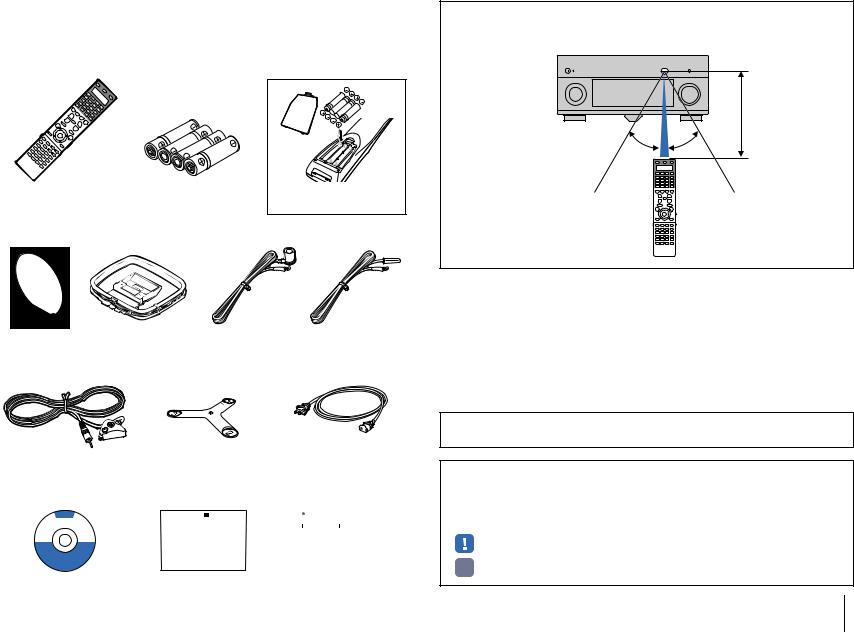
Accessories
Check that the following accessories are supplied with the product.
Remote control |
Batteries (x4) |
*RX-A3020: |
AAA, LR03, UM-4 |
Insert the batteries the right way |
RX-A2020: |
AAA, R03, UM-4 |
round. |
AM antenna |
FM antenna |
|
*One of the above is supplied depending on the region *One of the above is supplied depending on the region
of purchase. |
of purchase. |
|
YPAO microphone |
Microphone base |
Power cable |
|
(RX-A3020 only) |
|
|
|
|
|
|
|
|
|
|
|
|
|
|
|
|
|
*The supplied power cable varies |
||||||||
|
|
|
|
|
|
|
*Using for angle measurement |
|||||||||||||||||
|
|
|
|
|
|
|
depending on the region of purchase. |
|||||||||||||||||
|
|
|
|
|
|
|
during YPAO. |
|
|
|
|
|
|
|
|
|
||||||||
CD-ROM |
Easy Setup Guide |
Safety Brochure |
||||||||||||||||||||||
(Owner’s Manual) |
|
|
|
|
|
|
|
|
|
|
|
|
|
|
|
|
|
|
||||||
|
|
|
|
|
|
|
|
|
|
|
|
|
|
|
|
|
|
|
|
|
|
|
|
|
|
|
|
|
|
|
|
|
|
|
|
|
|
|
|
|
|
|
|
|
|
|
|
|
|
|
|
|
|
|
|
|
|
|
|
|
|
|
|
|
|
|
|
|
|
|
|
|
|
|
|
|
|
|
|
|
|
|
|
|
|
|
|
|
|
|
|
|
|
|
|
|
|
|
|
|
|
|
|
|
|
|
|
|
|
|
|
|
|
|
|
|
|
|
|
|
|
|
|
|
|
|
|
|
|
|
|
|
|
|
|
|
|
|
|
|
|
|
|
|
|
|
|
|
|
|
|
|
|
|
|
|
|
|
|
|
|
|
|
|
|
|
|
|
|
|
|
|
|
|
|
|
|
|
|
|
|
|
|
|
|
|
|
|
|
|
|
|
|
|
|
|
|
|
|
|
|
|
|
|
|
|
|
|
|
|
|
|
|
|
|
|
|
|
|
|
|
|
|
|
|
|
|
|
|
|
|
|
|
|
|
|
|
|
|
|
|
|
|
|
|
|
|
|
|
Operating range of the remote control
•Point the remote control at the remote control sensor on the unit and remain within the operating range shown below.
Within
6 m (20 ft)
30° 30°
•The illustrations of the main unit and remote control used in this manual are of the RX-A3020 (U.S.A. model), unless otherwise specified.
•Some features are not available in certain regions.
•Due to product improvements, specifications and appearance are subject to change without notice.
•This manual explains operations using the supplied remote control.
•This manual describes all the “iPod”, “iPhone” and “iPad” as the “iPod”. “iPod” refers to “iPod”, “iPhone” and “iPad”, unless otherwise specified.
• indicates precautions for use of the unit and its feature limitations.
•  indicates supplementary explanations for better use.
indicates supplementary explanations for better use.
Accessories En 5
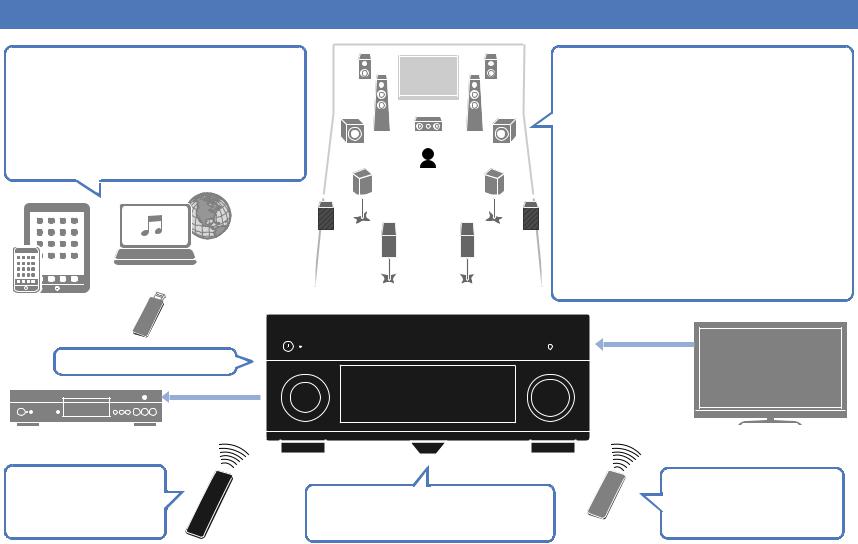
FEATURES
What you can do with the unit
Wide variety of supported content |
|
||
• iPod/iPhone/iPad |
.p.76 |
||
• USB |
.p.80 |
||
• Media server (PC/NAS) |
.p.83 |
||
• Internet radio |
.p.86 |
||
• AirPlay |
.p.88 |
||
|
|
|
|
Network contents
iPod/iPhone/iPad |
Audio |
|
|
|
USB device |
3D and 4K signals supported |
|
|
HDMI Control |
BD/DVD player |
Audio/Video |
|
|
Operating external devices with the supplied remote control
.p.136 |
The unit’s |
|
remote control |
|
|
|
|
|
|
|
|
Supports 2- to 9-channel (plus rear presence) speaker |
|
|
|
|
|
|
|
|
|
system and up to 2 subwoofer connections. Allows |
|
|
|
|
|
|
|
|
|
you to enjoy favorite acoustic spaces in various styles. |
|
|
|
|
|
|
|
|
|
• Automatically optimizing the speaker |
.p.50 |
|
|
|
|
|
|
|
|
settings to suit your room (YPAO) |
.p.64 |
|
|
|
|
|
|
|
|
• Reproducing stereo or multichannel |
|
|
|
|
|
|
|
|
|
sounds with the sound fields like |
|
|
|
|
|
|
|
|
|
actual movie theaters and concert halls |
|
|
|
|
|
|
|
|
|
(CINEMA DSP) |
|
|
|
|
|
|
|
|
|
• Enjoying compressed music with |
.p.68 |
|
|
|
|
|
|
|
|||
|
|
|
|
|
|
|
|
enhanced sound (Compressed Music |
|
|
|
|
|
|
|
|
|
Enhancer) |
|
|
|
|
|
|
|
|
|
• Bi-amp connections, channel |
.p.24 |
|
|
|
|
|
|
|
|
expansion (with external power-amp) |
|
|
|
|
|
|
|
|
|
and multi-zone configurations to |
|
|
|
|
|
|
|
|
|
enhance your system |
|
Speakers |
|
|
|
|
|
|
|||
|
Audio |
|
|||||||
|
|
|
|
||||||
|
|
|
|
|
|
|
|
HDMI Control |
|
|
|
|
|
|
|
|
|
Audio |
|
|
|
|
|
|
|
|
|
Video |
|
|
|
|
|
|
|
|
|
TV |
|
AV receiver (the unit)
Change the input source and favorite settings with one touch (SCENE)
.p.61 TV remote control
FEATURES
Sequential operation of a TV, AV receiver, and BD/DVD player (HDMI Control)
.p.158
What you can do with the unit |
En 6 |
|
|
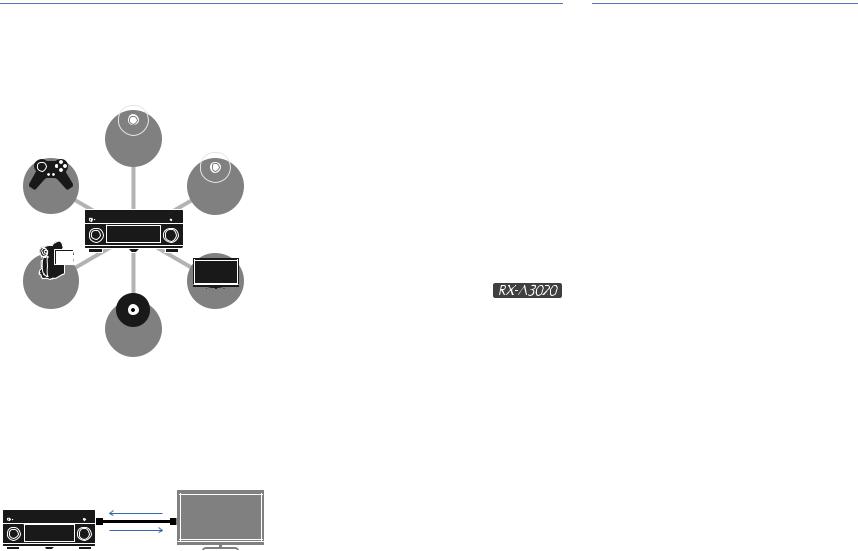
Full of useful functions!
Connecting various devices (p.41)
A number of HDMI jacks and various input/output jacks on the unit allow you to connect video devices (such as BD/DVD players), audio devices (such as CD players), game consoles, camcorders, and other devices.
BD/DVD player
Game |
CD player |
console |
|
Listening to FM/AM radio (p.69)
The unit is equipped with a built-in FM/AM tuner. You can register up to 40 favorite radio stations as presets.
Enjoying pure high fidelity sound (p.68)
When the Pure Direct mode is enabled, the unit plays back the selected source with the least circuitry, which lets you to enjoy Hi-Fi sound quality.
Easy operation with a TV screen
You can navigate through different types of content (such as iPod, USB, and network), view information, or easily configure the settings using the on-screen menu.
Camcorder
TV
Turntable
Playing back TV audio in surround sound with a single HDMI cable connection (Audio Return Channel: ARC) (p.35)
When using an ARC -compatible TV, you only need one HDMI cable to enable video output to the TV, audio input from the TV, and the transmission of HDMI Control signals.
HDMI Control
TV audio
Video from external device
Low power consumption
The ECO mode (power saving function) reduces the unit’s power consumption (p.130).
Backlight illumination remote control
The backlight illumination allows you to easily operate the remote control even in a dark home theater room.
Useful tips
I want to connect a playback device using HDMI for
video and non-HDMI for audio...
Use “Audio Select” in the “Option” menu to specify the type of an audio input jack to be used for the corresponding input source (p.101).
Video and audio are not synchronized...
Use “Lipsync” in the “Setup” menu to adjust the delay between video and audio output (p.118).
I want to hear audio from the TV speakers...
Use “Audio Output” in the “Setup” menu to select the output destination of signals input into the unit (p.122). Your TV speakers may be selected as an output destination.
I want to change the on-screen menu language...
Use “Language” in the “Setup” menu to select a language from English, Japanese, French, German, Spanish, Russian and Chinese (p.49).
I want to update the firmware...
Use “FIRM UPDATE” in the “ADVANCED SETUP” menu to update the unit’s firmware (p.135). If the unit is connected to the Internet, a message will be displayed on the TV when a firmware update is available (p.144).
Many other settings are available that let you to customize the unit. For details, see the following pages.
•Input settings (p.103)
•Scene settings (p.106)
•Sound program and surround decoder settings (p.109)
•Various function settings (p.112)
•Information view (such as audio signal and video signal) (p.131)
•System settings (p.133)
FEATURES What you can do with the unit |
En 7 |
|
|
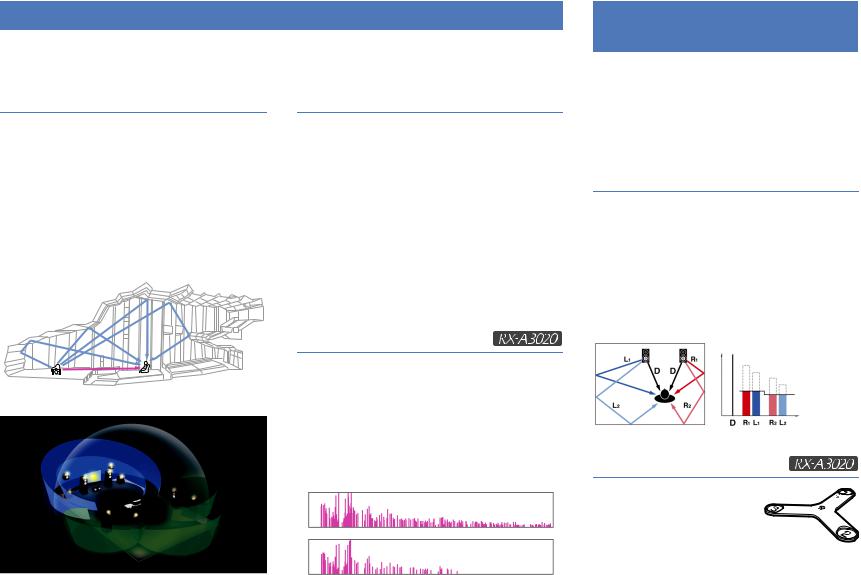
CINEMA DSP
The excitement of a concert hall and the powerful sense of being inside a movie - we all want to enjoy these experiences in our own living room. Yamaha has pursued the fulfillment of these desires for more than 20 years, and this fulfillment has now taken shape as the Yamaha AV receivers.
What is a sound field?
We perceive sound from a voice or an instrument not only as the sounds that are heard directly but also as the “reflected” or “reverberant” sound that has been reflected by the walls or ceiling of the building. The character of the reflected and reverberant sound is affected by the shape, size, and material of the building, and all of these sounds taken together are what give us the auditory sensation of being in that specific place. This unique acoustical character of a specific space is what we call the “sound field”.
Conceptual diagram of a concert hall's sound field
Conceptual diagram of a sound field created by the unit
CINEMA DSP/CINEMA DSP 3D
Yamaha has accumulated a massive amount of acoustical data by analyzing the actual sound fields of concert halls and performance spaces around the world. “CINEMA DSP” allows this data to be applied to create sound fields. This unit contains a wide variety of sound programs using CINEMA DSP.
By selecting a sound program that is appropriate to the content of the playback source such as movies, music, or games, you can maximize the acoustical effectiveness of that specific content. (For example, a sound program designed for movies can give you the sensation of actually being in that scene.)
In addition, the “CINEMA DSP 3D” function uses 3-dimensional sound field data that includes the axis of height, generating an even more realistic sound field with a spatial sense.
CINEMA DSP HD3
“CINEMA DSP HD³” is Yamaha's flagship 3D sound field playback technology that takes full advantage of the massive amount of acoustic reflection data included in the sound field data. With support for rear presence speaker output, it delivers more than twice as much capability for generating acoustic reflections as conventional CINEMA DSP 3D, in addition to high-frequency playback capability, delivering an utterly natural and powerful spatial sound field.
Capability for reproducing reflections
(when the sound program “Hall in Munich” is selected)
Level |
CINEMA DSP HD³ |
|
CINEMA DSP 3D
Time
Optimizing speaker settings for the environment (YPAO)
The included YPAO microphone can be used to analyze the environment so that this information can be used to automatically adjust various settings for the speakers and the sound field. This allows the distinctive character of the content you are hearing to be maximized, and optimizes the effectiveness of Yamaha's sound field generating technology for your specific listening environment.
YPAO-R.S.C.
In rooms that have not been designed or constructed with acoustics in mind, reflections from the walls or ceiling can cause problems such as a blurred low-frequency range or a smearing of the acoustical image. “YPAO-R.S.C.” is technology that reduces only the unwanted reflections that can be difficult to avoid in a typical home. This corrects the tonal changes and inconsistencies in the sound field that can occur due to speaker placement, thus creating a listening environment comparable to that of a room specifically designed for acoustic perfection.
Level
Angle measurement
The direction (angle) of the front speakers, surround speakers,
and presence speakers as seen from the listening position is measured, and compensation
is applied to the sound field in order to maximize the
effectiveness of the CINEMA DSP sound field.
FEATURES What you can do with the unit |
En 8 |
|
|
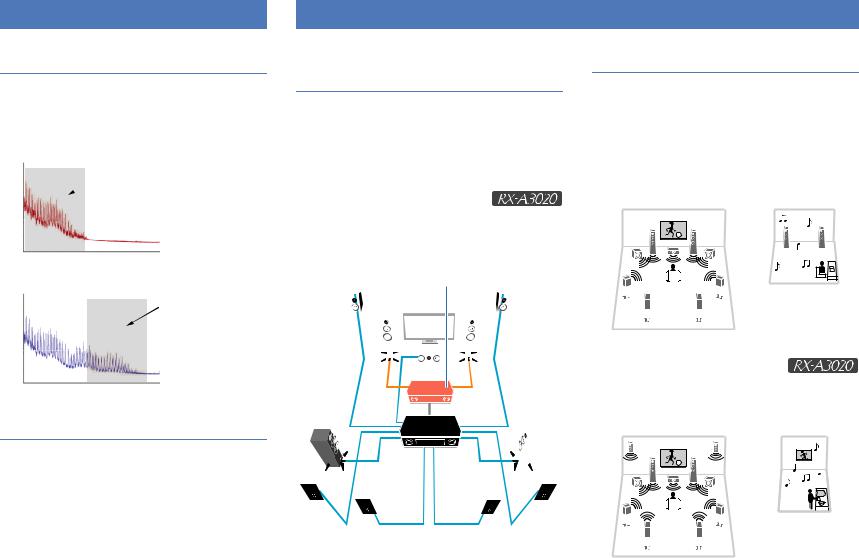
Unrivaled audio and video quality
High-resolution music enhancer
Hi-bit high-sampling extension up to 96 kHz / 24-bit can be applied to lossless 44.1/48 kHz content such as from a CD (2-channel PCM) or a FLAC file for further heightening of the musicality in the original content (p.101)
Before processing
Loudness |
Playback bandwidth of a 44.1/48 kHz |
|
signal (such as a CD) |
||
|
||
|
Frequency |
|
After processing |
|
|
Loudness |
Playback bandwidth of a |
|
88.2/96 kHz signal |
||
|
Frequency
High-quality video processing
From low-quality digital video to BD (Blu-ray disc) images, any content can be played back as a high-quality image (p.119).
•High-performance I/P conversion, high-performance scaling
•Powerful noise reduction
•Resolution enhancement adds more detail
The RX-A3020 can also apply fine touches such as noise reduction and resolution enhancement.
Expandable to meet diverse needs
Support for bi-amp connections and external power amp expansion
To obtain even high audio quality, you can connect front speakers that support power amp expansion, or expand your system by adding an external power amp (such as a Hi-Fi amp).
For details, refer to “Advanced speaker configuration” (p.24).
The best expandability in Yamaha
By connecting an external power amp,
you can enjoy the highest peak of CINEMA DSP - an 11.2-channel 3-dimensional sound field.
(Example)
External power amp
Multi-zone function
The multi-zone function (p.90) allows you to play back different input sources in the room where the unit is installed (main zone) and in other rooms (such as Zone2).
(The following shows examples of use.)
Enjoying music using speakers in another room
While enjoying multi-channel playback in your living room, you can listen to music through the speakers of a different room.
Study room (such as Zone2)
Living room (main zone)
Enjoying videos using a TV in another room (HDMI connection)
While enjoying multi-channel playback in your living room, you can enjoy videos and music being input via HDMI on a TV in a different room.
Kitchen
(such as Zone4)
Living room (main zone)
FEATURES What you can do with the unit |
En 9 |
|
|
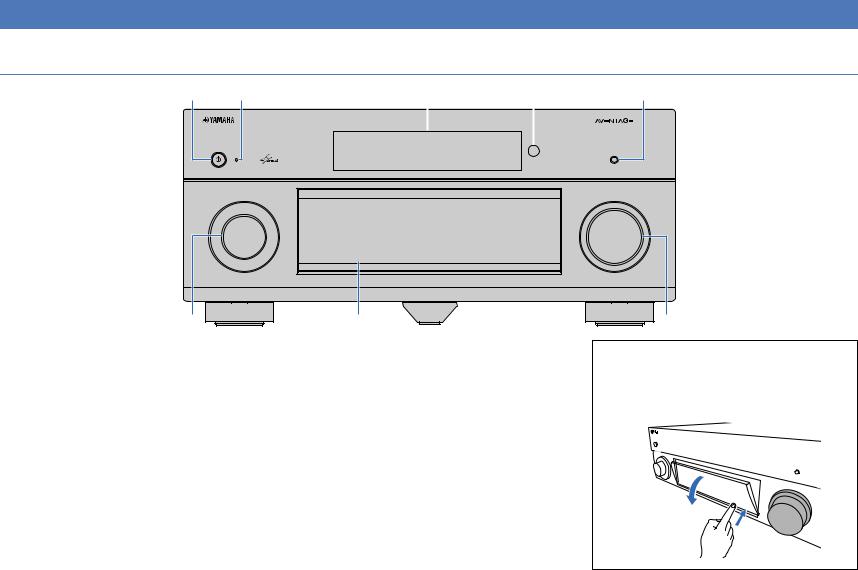
Part names and functions
Front panel
1 |
2 |
3 |
4 |
5 |
|||||
|
|
|
|
|
|
|
|
|
|
|
|
|
|
|
|
|
|
|
|
|
|
|
|
|
|
|
|
|
|
|
|
|
|
|
|
|
|
|
|
MAIN ZONE
INPUT
ON SCREEN
RETURN
6
OPTION TONE/BALANCE |
STRAIGHT |
SCENE |
|
INFO |
MEMORY |
PRESET |
|
|
1 |
2 |
3 |
|
4 |
|
|
PROGRAM |
MULTI ZONE |
|
FM |
AM |
TUNING |
||
ENTER |
|
|
|
|
|
|
|
|
ZONE 2 |
ZONE 3 |
ZONE 4 |
|
ZONE CONTROL |
|
|
DISPLAY |
|
|
|
|
|
|
|
PHONES |
|
|
VIDEO AUX |
|
|
||
YPAO MIC |
|
|
|
|
|
|
|
USB |
|
|
|
|
|
|
|
|
SILENT CINEMA |
|
|
|
|
|
|
5V 2.1A |
|
VIDEO |
L AUDIO |
R |
OPTICAL |
HDMI IN |
|
7
1 MAIN ZONE zkey |
7 Front panel door |
Turns on/off (standby) the unit. |
For protecting controls and jacks (p.11) |
2 Standby indicator |
8 VOLUME knob |
Lights up when the unit is in standby mode under any of the |
Adjusts the volume. |
following conditions. |
|
• HDMI Control is enabled (p.122) |
|
• Standby Through is enabled (p.123) |
|
• Network Standby is enabled (p.124) |
|
• An iPod is being charged (p.76) |
|
3 Front display |
|
Displays information (p.12). |
|
4 Remote control sensor |
|
Receives remote control signals (p.5). |
|
5 PURE DIRECT key |
|
Enables/disables Pure Direct (p.68). |
|
6 INPUT knob |
|
Selects an input source. |
|
PURE DIRECT
VOLUME
8
Opening the front panel door
•To use controls or jacks behind the front panel door, gently press the bottom of the door to open it. Keep the door closed when not using controls or jacks behind the front panel door. (Be careful not to trap your fingers.)
FEATURES Part names and functions |
En 10 |
|
|
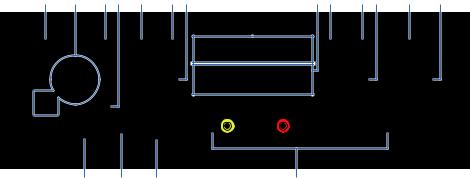
■ Inside of the front panel door
9 0 AB C DE |
F |
GH IJ |
9 ON SCREEN key
Displays the on-screen menu on the TV.
0 Menu operations keys
Cursor keys Select a menu or a parameter. ENTER Confirms a selected item. RETURN Returns to the previous screen.
ON SCREEN |
OPTION |
TONE/BALANCE |
STRAIGHT |
|
|
|
1 |
|
|
PROGRAM |
|
|
ENTER |
|
|
|
|
|
ZONE 2 |
RETURN |
DISPLAY |
|
|
 PHONES
PHONES
YPAO MIC
USB
SILENT CINEMA
5V 2.1A
M N O
SCENE |
|
INFO |
MEMORY |
|
2 |
3 |
|
4 |
|
MULTI ZONE |
|
FM |
AM |
|
ZONE 3 |
ZONE 4 |
|
ZONE CONTROL |
|
|
|
VIDEO AUX |
|
|
VIDEO |
L AUDIO |
R |
OPTICAL |
HDMI IN |
P
G MULTI ZONE keys
ZONE 2–4 |
(ZONE 4: RX-A3020 only) |
|
Enables/disables the audio output to |
|
each zone (p.95). |
ZONE CONTROL |
Changes the zone that is controlled by |
|
the keys and knobs on the front panel |
|
(p.95). |
A OPTION key |
H INFO key |
Displays the option menu (p.98). |
Selects the information displayed on the front display (p.97). |
B DISPLAY key |
I MEMORY key |
Displays status information on the TV (p.97). |
Registers FM/AM radio stations as preset stations (p.70). |
C TONE/BALANCE key
Adjusts the high-frequency range and low-frequency range of output sounds (p.99).
Adjusts the right/left channel volume balance for Zone2 or Zone3 (p.96).
D STRAIGHT key
Enables/disables the straight decode mode (p.67).
E PROGRAM keys
Select a sound program or a surround decoder (p.63).
F SCENE keys
Select the registered input source, sound program, and various settings with one touch. Also, turns on the unit when it is in standby mode (p.61).
J FM and AM keys
Switch between FM and AM (p.69).
K PRESET keys
Select a preset FM/AM radio station (p.70).
L TUNING keys
Select the radio frequency (p.69).
M USB jack
For connecting a USB storage device (p.80) or an iPod (p.76).
N YPAO MIC jack
For connecting the supplied YPAO microphone (p.50).
K L
(RX-A3020)
PRESET
TUNING
O PHONES jack
For connecting headphones.
P VIDEO AUX jacks
For connecting devices, such as camcorders and game consoles (p.44).
FEATURES Part names and functions |
En 11 |
|
|

Front display (indicators)
1 2 3 4 5 6 7 8
|
|
|
|
|
|
|
|
|
|
|
|
|
|
|
|
|
|
|
|
|
|
|
|
|
|
|
|
|
|
|
|
|
|
|
|
|
|
|
|
|
|
|
|
|
|
|
|
|
|
|
|
|
|
|
|
|
|
|
|
|
|
|
|
|
|
|
|
|
|
|
|
|
|
|
|
|
|
|
|
|
|
|
|
|
|
|
|
|
|
|
|
|
|
|
|
|
|
|
|
|
|
|
|
|
|
|
|
|
|
|
|
|
|
|
|
|
|
|
|
|
|
|
|
|
|
|
|
|
|
|
|
|
|
|
|
|
|
|
|
|
|
|
|
|
|
|
|
|
|
|
|
|
|
|
|
|
|
|
|
|
|
|
|
|
|
|
|
|
|
|
|
|
|
|
|
|
|
|
|
|
|
|
|
|
|
|
|
|
|
|
|
|
|
|
|
|
|
|
|
|
|
|
|
|
|
|
|
|
|
|
|
|
|
|
|
|
|
|
|
|
|
|
|
|
|
|
|
|
|
|
|
|
|
|
|
|
|
|
|
|
|
|
|
|
|
|
|
|
|
|
|
|
|
|
|
|
|
HD |
|
|
|
|
|
|
|
|
|
|
|
|
|
|
|
|
|
|
|
|
|
|
|
|
|
|
|
|
|
|
|
|
|
|
|
|
|
|
|
MUTE VOLUME |
||
|
|
|
|
|
|
|
|
|
|
|
|
|
|
|
|
|
|
|
|
|
|
|
|
|
|
|
|
|
|
|
|
|
|
|
||||||||
STEREO TUNED |
|
PARTY |
|
|
|
|
|
|
|
|
|
|
|
|
|
|
|
|
|
|
|
|
|
|
|
|
|
|
|
|
|
|
||||||||||
|
|
|
|
|
|
|
|
|
|
|
|
|
|
|
|
|
|
|
|
|
|
|
|
|
|
|
|
|
|
|
|
|
|
|
|
|
|
|
|
|
ADAPTIVE DRC |
|
|
|
|
|
|
ZONE |
ZONE ZONE |
|
|
|
|
|
|
|
|
|
|
|
|
|
|
|
|
|
|
|
|
|
|
|
|
|
|
|
|
|
|
||||||
IN OUT 1 OUT 2 |
2 |
3 |
4 |
PL |
L C R PR |
|
ENHANCER |
SLEEP |
|
SL SW1 |
SW2 SR |
||
|
|
HD 3 |
||||
|
|
PL |
SBL SB SBR PR |
|||
|
|
|
|
|
|
(RX-A3020 U.S.A. model) |
9 |
0 |
A B |
B C |
1HDMI
Lights up when HDMI signals are being input or output.
IN
Lights up when HDMI signals are being input.
OUT1/OUT2
Indicates the HDMI OUT jacks currently outputting an HDMI signal.
2STEREO
Lights up when the unit is receiving a stereo FM radio signal.
TUNED
Lights up when the unit is receiving an FM/AM radio station signal.
HD
(U.S.A. model only)
Lights up when the unit is receiving an HD Radio station signal.
3ZONE indicators
Lights up when Zone2, Zone3 or Zone4 (RX-A3020 only) is enabled (p.95).
4PARTY
Lights up when the unit is in the party mode. (p.96)
5 Information display
Displays the current status (such as input name and sound mode name). You can switch the information by pressing INFO (p.97).
6MUTE
Blinks when audio is muted.
7Volume indicator
Indicates the current volume.
8ADAPTIVE DRC
Lights up when Adaptive DRC (p.99) is working.
9ENHANCER
Lights up when Compressed Music Enhancer (p.68) is working.
0 CINEMA DSP indicator
(RX-A3020)
“CINEMA DSP HD” lights up when CINEMA DSP (p.64) is working. “CINEMA DSP !” lights up when CINEMA DSP HD³ is activated.
(RX-A2020)
“CINEMA DSP” lights up when CINEMA DSP (p.64) is working. “CINEMA DSP n” lights up when CINEMA DSP 3D
is activated.
ASLEEP
Lights up when the sleep timer is on.
BCursor indicators
Indicate the remote control cursor keys currently operational.
CSpeaker indicators
Indicate speaker terminals from which signals are output. AFront speaker (L)
SFront speaker (R) DCenter speaker FSurround speaker (L)
GSurround speaker (R) HSurround back speaker (L) JSurround back speaker (R) KSurround back speaker
ZFront/rear presence speakers (L) XFront/rear presence speakers (R) CSubwoofer (1)
VSubwoofer (2)
FEATURES Part names and functions |
En 12 |
|
|

Rear panel
1 2 |
|
|
3 456 7 |
89 |
|
|
|
|
|
|
|
0 |
A |
B |
|
|
C |
||||||||||
DC OUT |
|
NETWORK |
|
|
|
HDMI OUT |
|
|
|
|
|
|
|
|
|
HDMI |
|
|
|
|
|
|
|
|
|||
5V |
0.5A |
|
|
( 3 NET ) |
|
|
|
AV 1 |
AV 2 |
|
|
AV 3 |
|
AV 4 |
|
AV 5 |
|
AV 6 |
AV 7 |
|
|
|
|||||
|
|
|
|
|
|
|
|
1 |
|
2 |
|
|
|
|
|
|
|
|
|||||||||
|
|
|
|
|
|
|
|
ARC |
(ZONE OUT) |
(1 BD/DVD) |
|
|
|
|
|
|
|
|
|
|
|
|
|
|
|
||
PHONO |
AV 1 |
|
AV 2 |
AV 3 |
AV 4 |
AV OUT |
MONITOR OUT/ |
|
|
|
COMPONENT VIDEO |
|
|
|
|
|
|
|
|
|
|
|
TRIGGER |
||||
|
(1 BD/DVD) |
|
|
|
|
|
Y |
PB |
PR |
Y |
AV 3 |
PB |
C |
PR |
|
|
|
|
|
|
|
OUT |
|||||
|
|
|
|
|
|
|
ZONE OUT |
|
|
|
|
|
|
|
|
||||||||||||
|
|
|
|
|
|
|
|
|
AV 1 |
|
|
|
|
|
|
|
|
|
|
|
|
|
|
|
|
|
1 |
|
|
|
|
|
|
|
|
|
A |
|
|
|
|
|
|
|
|
|
MONITOR OUT/ZONE OUT |
|
REMOTE |
|
|
||||
|
|
|
|
|
|
|
|
|
|
|
|
|
|
|
|
|
|
|
|
|
|
||||||
|
|
|
|
|
|
|
|
|
|
|
|
|
|
|
|
|
|
|
Y |
PB |
PR |
|
1 |
2 |
|
|
|
GND |
|
|
|
|
|
|
|
|
|
|
|
|
|
|
|
|
|
|
IN |
OUT |
IN |
OUT |
|
|
|||
|
|
|
|
|
|
|
|
|
|
|
|
|
|
|
|
|
|
|
|
|
|
|
|||||
|
|
|
|
|
|
|
|
|
AV 2 |
|
|
|
|
|
|
|
|
|
|
|
|
|
|
|
|
|
2 |
|
|
|
|
|
|
|
|
|
B |
|
|
|
|
|
|
|
|
|
|
|
|
|
|
|
|
|
|
|
|
|
|
|
|
|
|
|
|
|
|
|
|
|
|
D |
|
|
|
|
|
|
|
|
|
|
|
|
|
|
|
|
|
|
|
|
|
|
|
|
|
AV 4 |
|
|
|
|
|
|
|
|
|
12V |
0.1A |
||
|
|
|
|
|
|
|
AUDIO 1 |
AUDIO 2 |
AUDIO 3 |
AUDIO 4 |
|
MULTI CH INPUT |
|
CENTER |
|
ZONE OUT/PRE OUT |
|
PRE OUT |
(SINGLE) |
(FRONT) 1 |
|
|
|
|
|||
L |
|
|
|
|
|
|
(2 TV) |
|
|
|
|
|
|
|
|
|
|
|
|
|
|
||||||
R |
|
|
|
|
|
|
|
|
|
|
|
|
|
|
|
|
|
|
|
|
|
|
2 |
|
|
|
|
|
|
|
|
|
|
|
|
|
|
|
FRONT |
SURROUND |
SUR. BACK |
SUBWOOFER |
ZONE 2 / |
ZONE 3 / |
FRONT |
SURROUND |
SUR. BACK |
(REAR) |
CENTER |
|
|
|
|||
|
1 COAXIAL |
2 |
COAXIAL |
3 OPTICAL |
4 OPTICAL |
|
5 OPTICAL |
6 COAXIAL |
|
|
F.PRESENSE |
R.PRESENSE |
SUBWOOFER |
|
|
|
|||||||||||
|
|
|
|
|
|
|
|
|
|
|
SPEAKERS |
|
|
|
|
|
|||||||||||
|
|
|
|
|
|
|
|
|
|
|
|
|
|
|
|
|
|
|
|
|
|
|
|
|
|
||
|
|
|
|
|
|
|
|
|
R |
SURROUND |
L |
R |
SURROUND BACK |
|
L |
ZONE 2/ZONE 3/R.PRESENCE |
CENTER |
R |
FRONT |
L |
|
||||||
|
|
|
|
|
|
|
|
|
|
|
|
|
|
|
|
|
|
|
R |
EXTRA SP2 |
L |
|
|
|
|
|
R |
|
|
|
ANTENNA |
|
|
|
|
|
|
|
|
|
|
|
|
|
|
|
|
|
|
|
|
|
|
|
|
|
|
|
HD Radio (4 RADIO) |
|
|
|
|
|
|
|
|
|
|
|
|
|
|
|
|
|
|
|
|
|
|
||
|
75Ω |
FM |
AM |
|
|
|
|
|
|
|
|
|
|
|
|
|
|
|
|
|
|
|
|
|
|
|
|
D E
(RX-A3020 U.S.A. model)
RS-232C |
ZONE 2/ZONE 3/F.PRESENCE/ |
AC IN |
|
BI–AMP |
|
|
EXTRA SP1 |
L |
|
SINGLE
*The area around the video/audio output jacks is marked in white on the actual product to prevent improper connections.
1 PHONO jacks
For connecting to a turntable (p.43).
2 DC OUT jack
For connecting to an optional accessory.
3 NETWORK jack
For connecting to a network (p.45).
4 AV 1–4 jacks
For connecting to video/audio playback devices and inputting video/audio signals (p.41).
5 AV OUT jacks
For outputting video/audio to a recording device (such as a VCR) (p.46).
6 MONITOR OUT/ZONE OUT (composite video/S-video) jacks
For connecting to a TV that supports composite video or S-video and outputting video signals (p.39) or for connecting to a zone video monitor used in Zone2 or Zone3 (p.92).
7 HDMI OUT 1 jack
For connecting to an HDMI-compatible TV and outputting video/audio signals (p.35). When using ARC, TV audio signal can also be input through the HDMI OUT 1 jack.
8 HDMI OUT 2 (ZONE OUT) jack (RX-A3020)
For connecting to an HDMI-compatible TV and outputting video/audio signals (p.40), or for connecting to an HDMI-compatible device used in Zone2 or Zone4 (p.93).
HDMI OUT 2 jack (RX-A2020)
For connecting to an HDMI-compatible TV and outputting video/audio signals (p.40).
9 COMPONENT VIDEO (AV 1–4) jacks
For connecting to video playback devices that support component video and inputting video signals (p.41).
0 HDMI (AV 1–7) jacks
For connecting to HDMI-compatible playback devices and inputting video/audio signals (p.41).
A MONITOR OUT/ZONE OUT (component video) jacks
For connecting to a TV that supports component video and outputting video signals (p.39) or for connecting to a zone video monitor used in Zone2 or Zone3 (p.92).
B REMOTE IN/OUT 1–2 jacks
For connecting to a Yamaha product that supports SCENE link playback (p.47) or for connecting to an infrared signal receiver/emitter that allows you to operate the unit and other devices from another room (p.94).
C TRIGGER OUT 1–2 jacks
For connecting to devices that support the trigger function (p.47).
D RS-232C terminal
This is a control expansion terminal for custom installation. Consult your dealer for details.
E VOLTAGE SELECTOR
(General model only)
Selects the switch position according to your local voltage (p.48).
FEATURES Part names and functions |
En 13 |
|
|
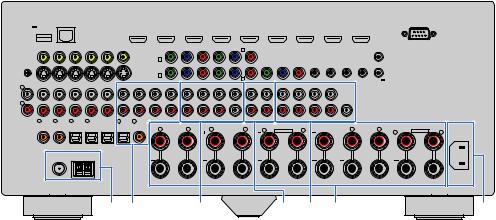
DC OUT |
NETWORK |
|
|
|
HDMI OUT |
|
|
|
|
HDMI |
|
|
RS-232C |
|||
5V |
0.5A |
|
( 3 NET ) |
|
|
AV 1 |
|
AV 2 |
AV 3 |
AV 4 |
AV 5 |
AV 6 |
AV 7 |
|||
|
|
|
|
|
|
1 |
|
2 |
|
|||||||
|
|
|
|
|
|
ARC |
|
(ZONE OUT) |
(1 BD/DVD) |
|
|
|
|
|
|
|
PHONO |
AV 1 |
AV 2 |
AV 3 |
AV 4 |
AV OUT |
MONITOR OUT/ |
|
|
COMPONENT VIDEO |
|
|
|
|
TRIGGER |
||
|
(1 BD/DVD) |
|
|
|
Y |
PB |
PR |
Y AV 3 |
PB C |
PR |
|
|
OUT |
|||
|
|
|
|
|
ZONE OUT |
|
|
|
||||||||
|
|
|
|
|
|
|
|
AV 1 |
|
|
|
|
|
|
|
|
|
|
|
|
|
|
|
|
1 |
|
|
|
|
|
|
|
|
|
|
|
A |
|
|
|
|
|
|
|
|
MONITOR OUT/ZONE OUT |
|
REMOTE |
|
|
|
|
|
||||
|
|
|
|
|
|
|
|
|
|
|
|
|
|
|
|
1 |
2 |
|
|
|
|
|
||||||
|
|
|
|
|
|
|
|
|
|
|
|
|
|
|
|
|
Y |
PB |
PR |
|
|
|
|
|
|
|
||
GND |
|
|
|
|
|
|
|
|
|
|
|
|
|
|
|
|
IN |
OUT |
IN |
OUT |
|
|
|
|
|
|||
|
|
|
|
|
|
|
|
|
|
|
|
|
|
|
|
|
|
|
|
|
|
|
|
|||||
|
|
|
|
|
|
|
|
AV 2 |
|
|
|
|
|
|
|
|
|
|
|
|
|
|
|
|
2 |
|
|
|
|
|
|
|
|
|
|
|
B |
|
|
|
|
|
|
|
|
|
|
|
|
|
|
|
|
|
|
|
|
|
|
|
|
|
|
|
|
|
|
|
|
|
|
D |
|
|
|
|
|
|
|
|
|
|
|
|
|
|
|
|
|
|
|
|
|
|
|
|
|
|
|
AV 4 |
|
|
|
|
|
|
|
|
12V |
0.1A |
|
|
|
||
|
|
|
|
|
|
AUDIO 1 |
AUDIO 2 |
AUDIO 3 |
AUDIO 4 |
|
MULTI CH INPUT |
|
CENTER |
ZONE OUT/PRE OUT |
|
PRE OUT |
(SINGLE) |
(FRONT) 1 |
|
|
|
|
|
|
|
|||
L |
|
|
|
|
|
(2 TV) |
|
|
|
|
|
|
|
|
|
|
|
|
|
|
|
|
||||||
R |
|
|
|
|
|
|
|
|
|
|
|
|
|
|
|
|
|
|
|
|
2 |
|
|
|
|
|
|
|
|
|
|
|
|
|
|
|
|
|
FRONT |
SURROUND |
|
SUR. BACK |
SUBWOOFER |
ZONE 2 / |
ZONE 3 / |
FRONT |
SURROUND |
SUR. BACK |
(REAR) |
CENTER |
|
|
|
|
|
|
|
1 COAXIAL |
2 |
COAXIAL |
3 OPTICAL |
4 OPTICAL |
5 OPTICAL |
6 COAXIAL |
|
|
|
F.PRESENSE |
R.PRESENSE |
SUBWOOFER |
|
|
|
|
|
|
||||||||||
|
|
|
|
|
|
|
|
SPEAKERS |
|
|
|
|
|
|
|
|
||||||||||||
|
|
|
|
|
|
|
|
|
|
|
|
|
|
|
|
|
|
|
|
|
|
|
|
ZONE 2/ZONE 3/F.PRESENCE/ |
AC IN |
|||
|
|
|
|
|
|
|
|
R |
SURROUND |
L |
|
R |
SURROUND BACK |
L |
ZONE 2/ZONE 3/R.PRESENCE |
CENTER |
R |
FRONT |
L |
|
||||||||
|
|
|
|
|
|
|
|
|
|
|
|
|
R |
|
L |
|
|
|
R |
BI–AMP |
L |
|
||||||
|
|
|
|
|
|
|
|
|
|
|
|
|
|
|
|
|
EXTRA SP2 |
|
|
|
|
|
EXTRA SP1 |
|
||||
|
|
ANTENNA |
(4 RADIO) |
|
|
|
|
|
|
|
|
|
|
|
|
|
|
|
|
|
|
|
|
|
|
|
||
|
|
HD Radio |
|
|
|
|
|
|
|
|
|
|
|
|
|
|
|
|
|
|
|
|
|
|
|
|||
75Ω |
FM |
|
AM |
|
|
|
|
|
|
|
|
|
|
|
|
|
|
|
|
|
|
|
|
|
|
|
|
|
|
|
|
|
|
|
|
|
|
|
|
|
|
|
|
SINGLE |
|
|
|
|
|
|
|
|
|
|
|
|
|
|
|
|
|
|
|
F G |
|
|
|
H |
|
|
|
|
|
|
I |
J |
K |
|
|
|
|
|
|
L |
||
(RX-A3020 U.S.A. model)
*The area around the video/audio output jacks is marked in white on the actual product to prevent improper connections.
F ANTENNA jacks
For connecting to FM and AM antennas (p.44).
G AUDIO 1–4 jacks
For connecting to audio playback devices and inputting audio signals (p.43).
H MULTI CH INPUT jacks
For connecting to a device that supports multi-channel output and inputting audio signals (p.46).
I ZONE OUT/PRE OUT jacks (RX-A3020)
For connecting to an external amplifier used in Zone2 or Zone3 and outputting audio (p.91), or for connecting to an external power amplifier for front presence or rear presence channels (p.33).
ZONE OUT jacks (RX-A2020)
For connecting to an external amplifier used in Zone2 or Zone3 and outputting audio (p.91).
J PRE OUT jacks
For connecting to a subwoofer with built-in amplifier (p.22) or to an external power amplifier (p.33).
K SPEAKERS terminals
For connecting to speakers (p.18).
L AC IN jack
For connecting the supplied power cable (p.48).
FEATURES Part names and functions |
En 14 |
|
|
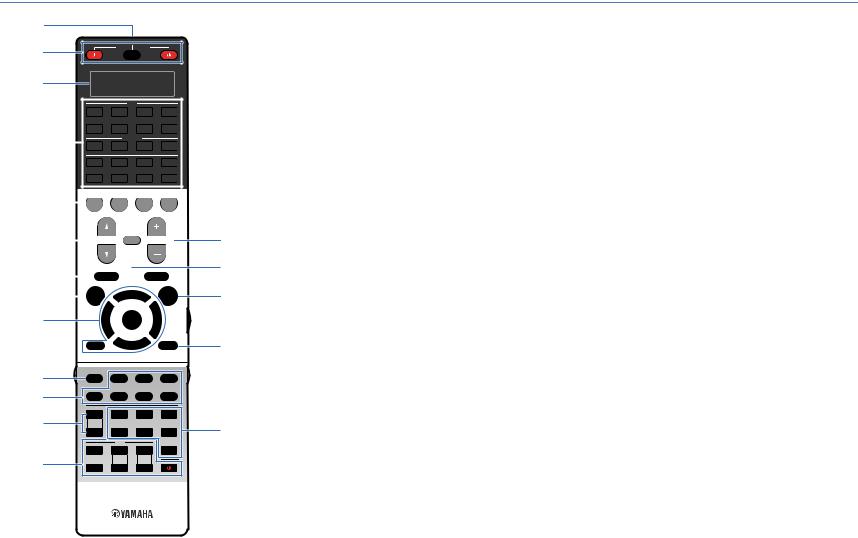
Remote control
1 |
|
2 |
SOURCE RECEIVER |
3 |
|
|
|
|
|
|
|
|
AV |
|
|
|
|
|
|
|
|
|
1 |
|
2 |
|
3 |
4 |
|
||||
|
|
|
5 |
|
6 |
|
7 |
V-AUX |
|
||||
4 |
|
|
|
|
|
|
AUDIO |
|
|
|
|||
|
|
1 |
|
2 |
|
3 |
4 |
|
|||||
|
|
|
|
PHONO |
MULTI |
USB |
NET |
|
|||||
|
|
|
|
TUNER |
[ A ] |
[ B ] |
[ C ] |
|
|||||
|
|
|
|
|
|
|
|
|
|
|
|
|
|
|
|
|
|
|
|
|
|
|
|
|
|
|
|
5 |
|
|
|
|
|
|
SCENE |
|
|
|
|
||
|
|
1 |
|
2 |
|
3 |
4 |
|
|||||
|
|
|
|
||||||||||
6 |
|
|
|
|
|
|
|
|
|
|
|
|
|
|
|
|
|
|
|
|
|
|
|
|
|
||
|
|
PROGRAM MUTE |
|
VOLUME |
|
||||||||
|
|
|
|
|
|
||||||||
7 |
|
|
|
|
|
||||||||
|
|
|
|
|
|
|
|
|
|
|
|
||
|
|
|
|
|
|
|
|
|
|
|
|
||
|
|
|
|
|
|
|
|
|
|
|
|
||
|
|
|
|
|
|
|
|
|
|
|
|
||
|
|
|
TOP MENU |
|
POP-UP/MENU |
|
|||||||
8 |
|
|
|
|
|
|
|||||||
|
|
|
|
|
|
|
|
|
|
|
|
||
|
ON SCREEN |
|
|
|
|
|
OPTION |
|
|||||
9 |
|
|
|
|
|
ENTER |
|
|
|
|
|
||
|
|
|
|
RETURN |
|
|
|
|
|
DISPLAY |
|
||
: |
MODE |
|
|
|
7 |
|
|
|
|
|
CLASSICAL |
LIVE |
ENTERTAIN |
|
A |
CLUB |
|||
|
|
|||
PRESET |
|
|
||
|
MOVIE |
STEREO |
STRAIGHT |
|
|
TV |
|
|
|
|
INPUT |
|
PURE |
|
|
|
DIRECT |
||
|
|
|
||
B |
TV VOL |
TV CH |
|
|
MUTE |
|
|
(RX-A3020)
1 Remote control signal transmitter
Transmits infrared signals.
2 SOURCE zkey
Turns on/off an external device.
SOURCE/RECEIVER key
Changes the device (the unit or external device) that is operated with the remote control (p.138). You can operate the unit when this key lights up in orange, and an external device when this key lights up in green.
RECEIVER zkey
Turns on/off (standby) the unit.
3 Display window
Displays remote control information.
4 Input selection keys
Select an input source for playback.
AV 1–7 |
AV 1–7 jacks |
CV-AUX VIDEO AUX jacks (on the front panel) AUDIO 1–4 AUDIO 1–4 jacks
DPHONO PHONO jacks
MULTI MULTI CH INPUT jacks
E |
USB |
USB jack (on the front panel) |
|
NET |
NETWORK jack (press repeatedly to select a |
||
|
|
|
desired network source) |
|
F |
TUNER |
FM/AM radio |
|
|||
|
|
[A], [B], [C] |
Change the external device to operate with the |
G |
remote control without switching the input |
|
source. |
||
|
||
|
5 SCENE keys |
|
|
Select the registered input source, sound program, and |
|
|
various settings with one touch. Also, turns on the unit when |
|
|
it is in standby mode (p.61). |
|
H |
6 PROGRAM keys |
|
Select a sound program (p.63). |
||
|
||
|
7 External device operation keys |
|
|
Let you play back and perform other operations for external |
|
|
devices (p.138). |
|
|
8 ON SCREEN key |
|
|
Displays the on-screen menu on the TV. |
9 Menu operation keys
Cursor keys Select a menu or a parameter. ENTER Confirms a selected item. RETURN Returns to the previous screen.
0 MODE key
Switches the iPod operation modes (p.78).
(U.S.A. model only) Selects an HD Radio audio program (p.71).
A PRESET keys
Select a preset FM/AM radio station (p.70).
B TV operation keys
Let you select TV input and volume, and perform other TV operations (p.137).
C VOLUME keys
Adjust the volume.
D MUTE key
Mutes the audio output.
E OPTION key
Displays the option menu (p.98).
F LIGHT key (RX-A3020 only)
Turns on the backlight of the remote control keys for about 10 seconds.
G DISPLAY key
Displays status information on the TV (p.97).
H Sound mode keys
Select a sound mode (p.63).
FEATURES Part names and functions |
En 15 |
|
|
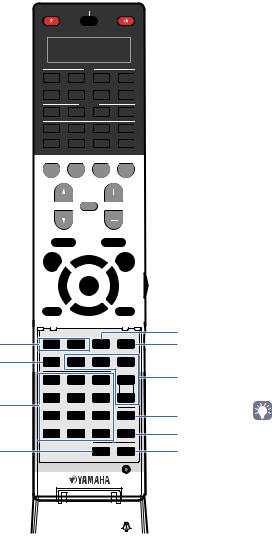
■ Inside of the remote control cover
 SOURCE RECEIVER
SOURCE RECEIVER
|
|
AV |
|
|
|
1 |
2 |
3 |
4 |
||
5 |
6 |
7 |
V-AUX |
||
|
|
AUDIO |
|
||
1 |
2 |
3 |
4 |
||
PHONO |
MULTI |
USB |
NET |
||
TUNER |
[ A ] |
[ B ] |
[ C ] |
||
|
|
SCENE |
|
|
|
1 |
2 |
3 |
4 |
||
PROGRAM MUTE |
|
VOLUME |
|||
TOP MENU |
|
POP-UP/MENU |
|||
|
ON SCREEN |
|
|
OPTION |
|
|
|
|
ENTER |
|
|
|
RETURN |
|
|
DISPLAY |
|
|
|
|
|
|
M |
I |
SUR. |
ENHANCER |
PARTY |
HDMI OUT |
N |
MODE |
|||||
DECODE |
|
|
|
||
J |
INFO |
MEMORY |
FM |
AM |
|
|
1 |
CLASSICAL2 |
LIVE |
ENTERTAIN |
O |
|
3 |
||||
|
|
|
CLUB |
|
|
|
PRESET |
|
|
TUN./ CH |
|
K |
4 |
MOVIE5 |
STEREO6 |
STRAIGHT |
|
|
TV |
|
|
P |
|
|
INPUT7 |
8 |
9 |
PURE |
|
|
SLEEP |
||||
|
|
|
|
DIRECT |
|
|
|
TV VOL |
TV CH |
|
Q |
|
MUTE10 |
0 |
ENT |
LEVEL |
|
L |
|
|
ZONE |
SETUP |
R |
(RX-A3020)
I Sound mode keys
Select a sound mode (p.63).
J INFO key
Selects the information displayed on the front display (p.97).
K Numeric keys
Let you enter numerical values, such as radio frequencies.
L ZONE key
Changes the zone that is controlled by the remote control (p.95).
M PARTY key
Turns on/off the party mode (p.96).
N HDMI OUT key
Selects HDMI OUT jacks to be used for video/audio output (p.60).
O Radio keys
Operate the FM/AM radio (p.69).
MEMORY |
Registers FM/AM radio stations as presets. |
FM |
Switches to FM radio. |
AM |
Switches to AM radio. |
TUN./CH |
Select the radio frequency. |
P SLEEP key
Switches the unit to standby mode automatically after a specified period of time has elapsed (sleep timer). Press repeatedly to set the time (120 min, 90 min, 60 min, 30 min, off).
Q LEVEL key
Adjusts the volume of each speaker (p.117).
R SETUP key
Switches the remote control to the setup mode (p.136).
•To operate external devices with the remote control, register a remote control code for each device before using (p.136).
FEATURES Part names and functions |
En 16 |
|
|

PREPARATIONS
General setup procedure
1 Connecting speakers (p.18)
2 |
Connecting a TV (p.35) |
|
|
3 |
Connecting playback devices (p.41) |
|
|
4 |
Connecting the FM/AM antennas (p.44) |
|
|
5 |
Connecting to a network (p.45) |
|
|
6 |
Connecting other devices (p.46) |
|
|
7 |
Connecting the power cable (p.48) |
|
|
8 |
Selecting an on-screen menu language |
|
(p.49) |
9Optimizing the speaker settings automatically (YPAO) (p.50)
Basic speaker configuration (p.19)
Select the speaker layout and connect the speakers to the unit.
Advanced speaker configuration (p.24)
Apply bi-amp connections, channel expansion (using an external power amplifier) or multi-zone configurations to enhance the system.
Connect a TV to the unit.
Connect video devices (such as BD/DVD players) and audio devices (such as CD players) to the unit.
Connect the supplied FM/AM antennas to the unit.
Connect the unit to a network.
Connect external devices such as recording devices.
After all the connections are complete, plug in the power cable.
Select the desired on-screen menu language.
Optimize the speaker settings, such as volume balance and acoustic parameters, to suit your room (YPAO).
This completes all the preparations. Enjoy playing movies, music, radio and other content with the unit!
PREPARATIONS General setup procedure |
En 17 |
|
|

1 Speaker connections 2 3 4 5 6 7 8 9
1 Connecting speakers
The unit has 9 built-in amplifiers. You can connect 2 to 11 speakers and up to 2 subwoofers to create the favorite acoustic space in your room.
You can also apply bi-amp connections, channel expansion (using an external power amplifier) or multi-zone configurations to enhance your system (p.24).
Caution
•Under its default settings, the unit is configured for 8-ohm speakers. When connecting 6-ohm speakers, set the unit’s speaker impedance to “6 Ω MIN”. In this case, you can also use 4-ohm speakers as the front speakers. For details, see “Setting the speaker impedance” (p.21).
Functions of each speaker
Speaker type |
Abbr. |
Function |
|
|
|
|
|
Front (L) |
1 |
Produce front right/left channel sounds (stereo sounds). |
|
|
|
||
Front (R) |
2 |
||
|
|||
|
|
|
|
Center |
3 |
Produces center channel sounds (such as movie dialogues and |
|
vocals). |
|||
|
|
|
|
Surround (L) |
4 |
Produce surround right/left channel sounds. Surround speakers |
|
|
|
also produce surround back channel sounds when no surround |
|
Surround (R) |
5 |
||
back speakers are connected. |
|||
|
|
|
|
Surround back (L) |
6 |
Produce surround back right/left channel sounds. |
|
|
|
||
Surround back (R) |
7 |
||
|
|||
|
|
|
|
Front presence (L) |
E |
|
|
|
|
Produce CINEMA DSP effect sounds. In combination with CINEMA |
|
Front presence (R) |
R |
||
DSP HD³ (RX-A3020) or CINEMA DSP 3D (RX-A2020) (p.64), the |
|||
Rear presence (L) |
T |
presence speakers create a natural 3-dimensional sound field in |
|
|
|
your room. |
|
Rear presence (R) |
Y |
|
|
|
|
|
|
|
|
Produces LFE (low-frequency effect) channel sounds and |
|
|
|
reinforces bass parts of other channels. |
|
Subwoofer |
9 |
This channel is counted as “0.1”. You can connect 2 subwoofers to |
|
|
|
the unit and place them on the right/left (or front/rear) sides of the |
|
|
|
room. |
|
|
|
|
•We recommend using presence speakers to have a full effect of the 3-dimensional sound fields. However, the unit creates Virtual Presence Speaker (VPS) using the front, center and surround speakers to produce 3-dimensional sound fields even when no presence speakers are connected (p.64).
•Use “Ideal speaker layout” (diagram on the right) as reference. You do not need to exactly adjust the speaker layout to this diagram since the YPAO function of the unit will automatically optimize the speaker settings (such as distances) to suit the speaker layout.
•When using only one surround back speaker, place it straight behind the listening position (middle of “SBL” and “SBR” in the diagram).
Ideal speaker layout
E |
|
R |
0.5 to 1 m |
|
0.5 to 1 m |
(1.6 to 3.3 ft) |
|
(1.6 to 3.3 ft) |
1 |
|
2 |
1.8 m |
|
1.8 m |
(5.9 ft) |
|
(5.9 ft) |
9 |
3 |
9 |
4 5
10°~30° |
10°~30° |
T Y
6 7
1.8 m |
|
0.3 m (1 ft) or more |
|
1.8 m |
|
|
|
||
(5.9 ft) |
|
|
|
(5.9 ft) |
PREPARATIONS Connecting speakers |
En 18 |
|
|
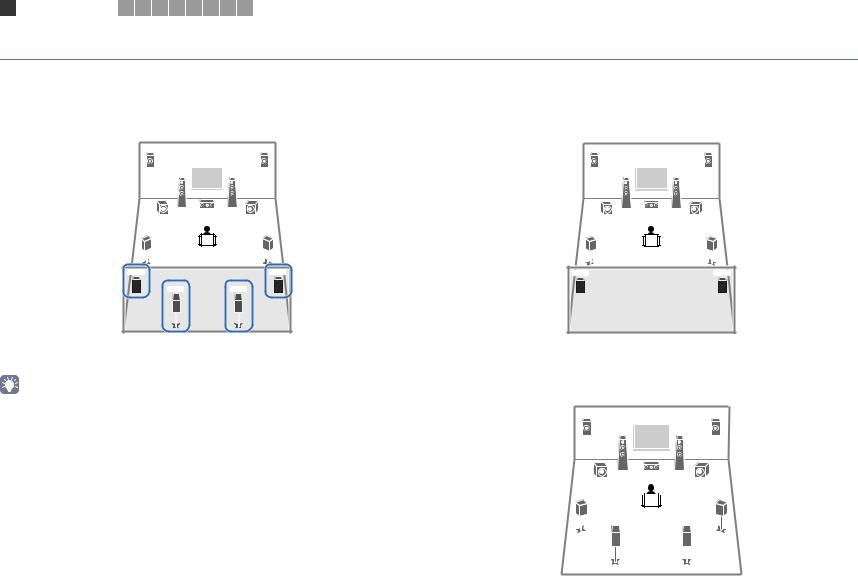
1 Speaker connections 2 3 4 5 6 7 8 9
Basic speaker configuration
■ Placing speakers in your room
Depending on the number of speakers, place the speakers and subwoofer in your room. This section describes the representative speaker layout examples.
9.2+2-channel system (using both surround back and rear presence speakers)
E R
1 |
|
2 |
9 |
3 |
9 |
9.2-channel system (using rear presence speakers)
E R
1 |
|
2 |
9 |
3 |
9 |
4 5
T Y
6 7
4 5
T Y
This speaker system brings out the full performance of the unit and allows you to enjoy a highly-natural 3-dimensional sound field with any contents.
This speaker system uses the front and rear presence speakers to produce a highly-natural 3-dimensional sound field, and is suited for enjoying 5.1-channel contents.
•The surround back speakers and rear presence speakers do not produce sounds simultaneously. The unit automatically changes the speakers to be used, depending on the selected sound program (p.64).
•(RX-A3020 only)
You can make an 11-channel system by using an external power amplifier (p.25).
9.2-channel system (using surround back speakers)
E R
1 |
|
2 |
9 |
3 |
9 |
4 
 5
5
6 7
This speaker system uses the front presence speakers to produce a natural 3-dimensional sound field, and also allows you to enjoy extended surround sounds using the surround back speakers.
PREPARATIONS Connecting speakers |
En 19 |
|
|
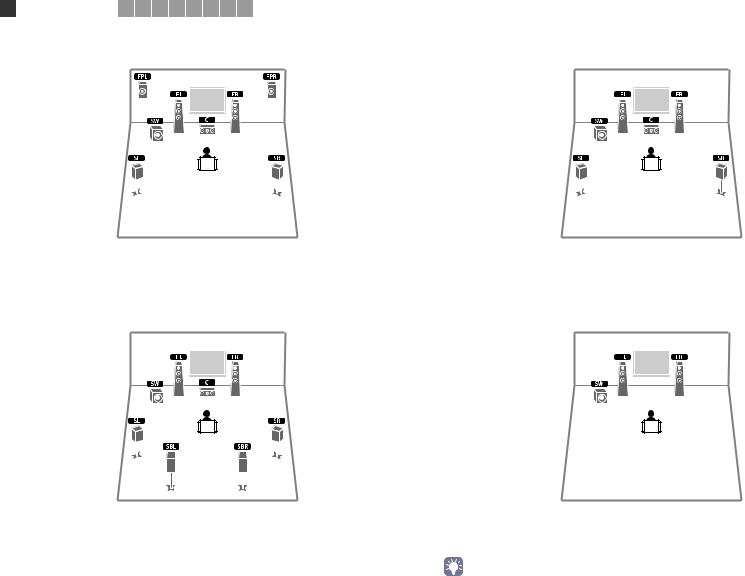
1 Speaker connections 2 3 4 5 6 7 8 9
7.1-channel system (using front presence speakers)
This speaker system uses the front presence speakers to produce a natural 3-dimensional sound field, and is suited for enjoying 5.1-channel contents.
7.1-channel system (using surround back speakers)
This speaker system creates Virtual Presence Speaker (VPS) using the front, center and surround speakers to produce a 3-dimensional sound field, and also allows you to enjoy extended surround sounds using the surround back speakers.
5.1-channel system
This speaker system creates Virtual Presence Speaker (VPS) using the front, center and surround speakers to produce a 3-dimensional sound field, and is suited for enjoying 5.1-channel contents.
2.1-channel system
Even when no surround speakers are connected, the unit creates the virtual surround speakers using the front speakers to allow you to enjoy multi-channel surround sound (Virtual CINEMA DSP).
• Add the center speaker to configure a 3.1-channel system.
PREPARATIONS Connecting speakers |
En 20 |
|
|
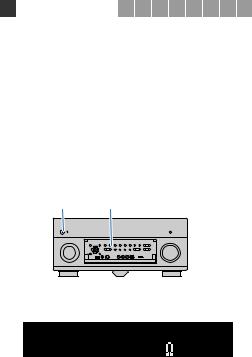
1 Speaker connections 2 3 4 5 6 7 8 9
■ Setting the speaker impedance
Under its default settings, the unit is configured for 8-ohm speakers. When connecting 6-ohm speakers, set the speaker impedance to “6 Ω MIN”. In this case, you can also use 4-ohm speakers as the front speakers.
1Before connecting speakers, connect the power cable to an AC wall outlet.
2While holding down STRAIGHT on the front panel, press MAIN ZONE z.
MAIN ZONE z STRAIGHT
3 Check that “SPEAKER IMP.” is displayed on the front display.
DOCK |
SP IMP. - |
S P E A K E R I M P . |
|
|
TAG |
|
|||
HD |
|
|||
STEREO TUNED PRE AMP PARTY |
MUTE VOLUME |
|||
|
|
ZONE ZONE ZONE |
8 M I N |
ADAPTIVE DRC |
IN OUT 1 OUT 2 |
2 3 4 |
PL L C R PR |
||
ENHANCER SLEEP |
SL SW1 SW SW2 SR |
|||
|
|
HD 3 |
||
|
|
PL SBL SB SBR PR |
||
|
|
|
|
|
4 Press STRAIGHT to select “6 Ω MIN”.
5Press MAIN ZONE zto set the unit to standby mode and remove the power cable from the AC wall outlet.
You are now ready to connect the speakers.
PREPARATIONS Connecting speakers |
En 21 |
|
|

1 Speaker connections 2 3 4 5 6 7 8 9
■ Connecting speakers
Connect the speakers placed in your room to the unit.
Cables necessary for connection (commercially available)
Speaker cables (x the number of speakers)
Caution
•Remove the unit’s power cable from an AC wall outlet and turn off the subwoofer before connecting the speakers.
•Ensure that the core wires of the speaker cable do not touch one another or come into contact with the unit’s metal parts. Doing so may damage the unit or the speakers. If the speaker cables short circuit, “Check SP Wires” will appear on the front display when the unit is turned on.
Speakers to be connected
+ |
+ |
||
|
|
|
|
– |
– |
||
|
|||
Audio pin cable (two for connecting two subwoofers)
Connection diagram
Refer to the following diagram and connect the speakers to the unit.
U O 3 |
U O |
U C |
U |
ZONE OUT/PRE OUT |
PRE OUT (SINGLE) (FRONT) 1 |
|
|
|
CENTER |
|
|
|
|
Speaker system |
|
Power Amp |
|
|
|
|
|
|
|
|
|
|
2 |
|
|
|
|
|
||
Room |
Speaker type |
Abbr. |
(the number of channels) |
|
The unit (rear) |
|
|
|
|
|
|
|
|
|
|
|
|
|||||||
|
Assign |
|
|
ZONE 2 / ZONE 3 / |
|
|
|
(REAR) |
|
|
|
|
|
|||||||||||
|
|
|
|
|
|
|
FRONT |
SURROUND SUR. BACK SUBWOOFER |
F.PRESENSE R.PRESENSE |
FRONT |
SURROUND |
SUR. BACK |
SUBWOOFER |
CENTER |
|
|
|
|
||||||
|
|
|
|
|
|
|
|
(p.114) |
|
|
|
|
|
|
|
SPEAKERS |
|
|
|
|
|
|
ZONE 2/ZONE 3/F.PRESENCE/ |
|
|
|
|
|
|
|
|
|
|
SURROUND |
|
|
SURROUND BACK |
|
ZONE 2/ZONE 3/R.PRESENCE |
CENTER |
|
FRONT |
R |
||||||
|
|
|
9+2 |
9 |
7 |
5 |
2 |
R |
|
L |
R |
|
L |
|
|
|
|
|
R |
|
BI–AMP |
L |
||
|
|
|
|
|
|
|
|
|
|
|
|
|
|
|
R EXTRA SP2 |
L |
|
|
|
|
|
EXTRA SP1 |
|
|
|
Front (L) |
1 ● |
● |
● |
● |
● |
|
|
|
|
|
|
|
|
|
|
|
|
|
|
|
|
|
|
|
Front (R) |
2 ● |
● |
● |
● |
● |
|
|
|
|
|
|
|
|
SINGLE |
|
|
|
Center |
3 ● |
● |
● |
● |
|
|
|
|
Surround (L) |
4 ● |
● |
● |
● |
|
|
|
|
Surround (R) |
5 ● |
● |
● |
● |
|
|
|
Main zone |
Surround back (L) |
6 ● |
c*1 |
c*3 |
|
Basic (default) |
|
|
|
Surround back (R) |
7 ● |
c*1 |
c*3 |
|
E |
|
R |
|
|
|
|
|
||||
|
Front presence (L) |
E ● |
● |
c*4 |
|
1 |
|
2 |
|
Front presence (R) |
R ● |
● |
c*4 |
|
|
|
|
|
Rear presence (L) |
T ● |
c*2 |
|
|
9 |
3 |
9 |
|
|
|
|
|
|
Rear presence (R) Y ● c*2
4 5
If you have nine speakers, use two of them as surround back speakers (*1) or rear presence speakers (*2). If you have seven speakers, use two of them as surround back speakers (*3) or front presence speakers (*4).
•You can also connect up to 2 subwoofers (with built-in amplifier) to the unit. When using 2 subwoofers, configure the “SWFR Layout” setting (p.116) in the “Setup” menu after connecting the power cable to an AC wall outlet.
•To use an external power amplifier (Hi-Fi amplifier, etc.) to enhance speaker output, see “Connecting an external power amplifier” (p.33).
T Y
6 7
• When using only one surround back speaker, connect it to the SINGLE jack (L side).
PREPARATIONS Connecting speakers |
En 22 |
|
|
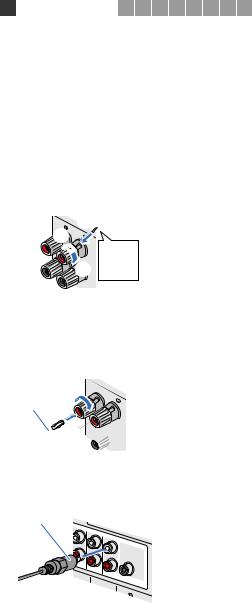
1 Speaker connections 2 3 4 5 6 7 8 9
Connecting speaker cables
Speaker cables have two wires. One is for connecting the negative (-) terminal of the unit and the speaker, and the other is for the positive (+) terminal. If the wires are colored to prevent confusion, connect the black wire to the negative and the other wire to the positive terminal.
a Remove approximately 10 mm (3/8”) of insulation from the ends of the speaker cable, and twist the bare wires of the cable firmly together.
b Loosen the speaker terminal.
c Insert the bare wires of the cable into the gap on the side (upper right or bottom left) of the terminal.
d Tighten the terminal.
+ (red)
+ 
 b
b
c
- 
– (black)
d a
Using a banana plug
(U.S.A., Canada, China, Australia and General models only)
a Tighten the speaker terminal.
b Insert a banana plug into the end of the terminal.
a + 
Banana plug

 b
b

Connecting the subwoofer (with built-in amplifier)
Use an audio pin cable to connect the subwoofer.
Audio pin cable
RE OUT
(S |
|
INGLE) |
( |
|
FRONT) |
1
SUR |
|
|
RUND |
SUR. |
|
|
( |
|
|
BACK |
|
|
|
SUBREAR) |
|
|
WOOFER |
|
CENTER |
|
CENTER
FRONT
PREPARATIONS Connecting speakers |
En 23 |
|
|
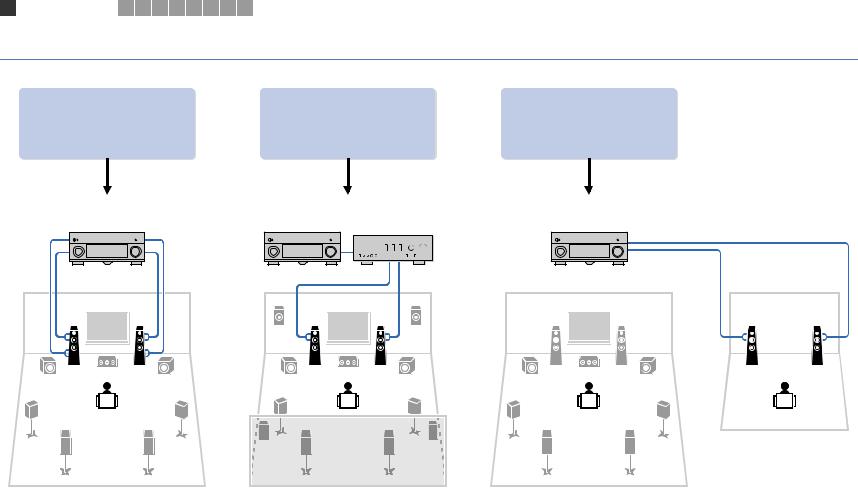
1 Speaker connections 2 3 4 5 6 7 8 9
Advanced speaker configuration
In addition to the basic speaker configuration (p.19), the unit also allows you to apply the following speaker configurations to enhance your system.
Using the four internal |
Combining with an external |
Using the excess internal |
|
power amplifier (Hi-Fi |
|||
amplifiers for front speakers to |
amplifiers for stereo speakers |
||
amplifier, etc.) to build an |
|||
have more high-quality sounds |
in another room |
||
extended system |
|||
|
|
||
Bi-amp connection |
Power-amp channel expansion |
Multi-zone configuration |
|
(Example) |
(Example) |
(Example) |
|
|
|
External power |
|
|
|
amplifier |
|
Bi-amp |
|
|
|
connection |
|
|
Zone2
Main zone
PREPARATIONS Connecting speakers |
En 24 |
|
|

1 Speaker connections 2 3 4 5 6 7 8 9
■ Available speaker configurations
(RX-A3020)
|
|
Main zone |
|
|
|
|
|
Speaker configuration |
|
|
|
Multi-zone |
Power Amp Assign (p.114) |
Page |
|
Output channel |
Bi-amp |
External power |
|||||
|
|
|
|
||||
|
(max) |
amplifier (required) |
|
|
|
||
|
|
|
|
|
|||
|
|
|
|
|
|
|
|
Using a bi-amp connection in the main zone |
7 |
c |
|
|
7ch BI-AMP |
26 |
|
|
|
|
|
|
|
|
|
Using a bi-amp connection in the main zone and power-amp channel |
9 |
c |
Front presence |
|
7ch BI-AMP +FP |
26 |
|
|
|
|
|
|
|
||
|
|
Front presence |
|
|
|
||
expansion (for presence channels) |
11 |
c |
|
7ch BI-AMP +FP+RP |
27 |
||
Rear presence |
|
||||||
|
|
||||||
|
|
|
|
|
|
||
|
|
|
|
|
|
|
|
|
11 |
|
Rear Presence |
|
9ch +RP |
27 |
|
|
|
|
|
|
|
|
|
Using power-amp channel expansion (for front and/or presence |
11 |
|
Front |
|
9ch +FRONT |
28 |
|
channels) |
|
|
|
|
|
|
|
11 |
|
Front presence |
|
7ch +FP+RP |
28 |
||
|
|
|
|||||
|
|
Rear presence |
|
||||
|
|
|
|
|
|
||
|
|
|
|
|
|
|
|
Using power-amp channel expansion (for front channels) and |
9 |
|
Front |
+1 room |
7ch +FRONT+1ZONE |
29 |
|
|
|
|
|
|
|
||
multi-zone speakers |
7 |
|
Front |
+2 rooms |
5ch +FRONT+2ZONE |
29 |
|
|
|
||||||
|
|
|
|
|
|
|
|
|
7 |
|
|
+1 room |
7ch +1ZONE |
30 |
|
|
|
|
|
|
|
|
|
Using multi-zone speakers |
9 |
|
|
+1 room |
9ch +1ZONE |
30 |
|
|
|
|
|
|
|
|
|
|
7 |
|
|
+2 rooms |
7ch +2ZONE |
31 |
|
|
|
|
|
|
|
|
(RX-A2020)
|
|
Main zone |
|
|
|
|
|
Speaker configuration |
|
|
|
Multi-zone |
Power Amp Assign (p.114) |
Page |
|
Output channel |
Bi-amp |
External power |
|||||
|
|
|
|
||||
|
(max) |
amplifier (required) |
|
|
|
||
|
|
|
|
|
|||
|
|
|
|
|
|
|
|
Using a bi-amp connection in the main zone |
7 |
c |
|
|
7ch BI-AMP |
26 |
|
|
|
|
|
|
|
|
|
Using power-amp channel expansion (for front channels) and |
9 |
|
Front |
+1 room |
7ch +FRONT+1ZONE |
29 |
|
|
|
|
|
|
|
||
multi-zone speakers |
|
|
|
|
|
|
|
7 |
|
Front |
+2 rooms |
5ch +FRONT+2ZONE |
29 |
||
|
|
||||||
|
|
|
|
|
|
|
|
|
7 |
|
|
+1 room |
7ch +1ZONE |
30 |
|
|
|
|
|
|
|
|
|
Using multi-zone speakers |
9 |
|
|
+1 room |
9ch +1ZONE |
30 |
|
|
|
|
|
|
|
|
|
|
7 |
|
|
+2 rooms |
7ch +2ZONE |
31 |
|
|
|
|
|
|
|
|
•When applying one of these configurations, you need to configure the “Power Amp Assign” setting (p.114) in the “Setup” menu.
•When applying a multi-zone configuration, you can select a zone (Zone2 or Zone3) to be assigned to the EXTRA SP 1–2 jacks in “Power Amp Assign” (p.114) in the “Setup” menu. By default, Zone2 is assigned to the EXTRA SP 1 jacks and Zone3 is assigned to the EXTRA SP 2 jacks. The following explanation is based on the assumption that you have not changed the default zone assignments.
PREPARATIONS Connecting speakers |
En 25 |
|
|

1 Speaker connections 2 3 4 5 6 7 8 9
7ch BI-AMP
Bi-amp
1 2
9  3
3  9
9
4 
 5
5
6 7
Speaker |
Connect to |
|
|
12 |
FRONT and EXTRA SP 1 (bi-amp connection) |
|
|
3 |
CENTER |
|
|
45 |
SURROUND |
|
|
67 |
SURROUND BACK |
|
|
ER |
(not used) |
|
|
TY |
(not used) |
|
|
9 |
SUBWOOFER 1–2 |
|
|
7ch BI-AMP +FP (RX-A3020 only)
Bi-amp
E R
via external amp |
via external amp |
1 2
9  3
3  9
9
4 
 5
5
6 7
Speaker |
Connect to |
|
|
12 |
FRONT and EXTRA SP 1 (bi-amp connection) |
|
|
3 |
CENTER |
|
|
45 |
SURROUND |
|
|
67 |
SURROUND BACK |
|
|
ER |
F.PRESENCE (PRE OUT) via external power amplifier |
|
|
TY |
(not used) |
|
|
9 |
SUBWOOFER 1–2 |
|
|
•When this configuration is applied, you cannot utilize the ZONE OUT/PRE OUT jacks for connecting an external amplifier for Zone2 (p.91).
PREPARATIONS Connecting speakers |
En 26 |
|
|
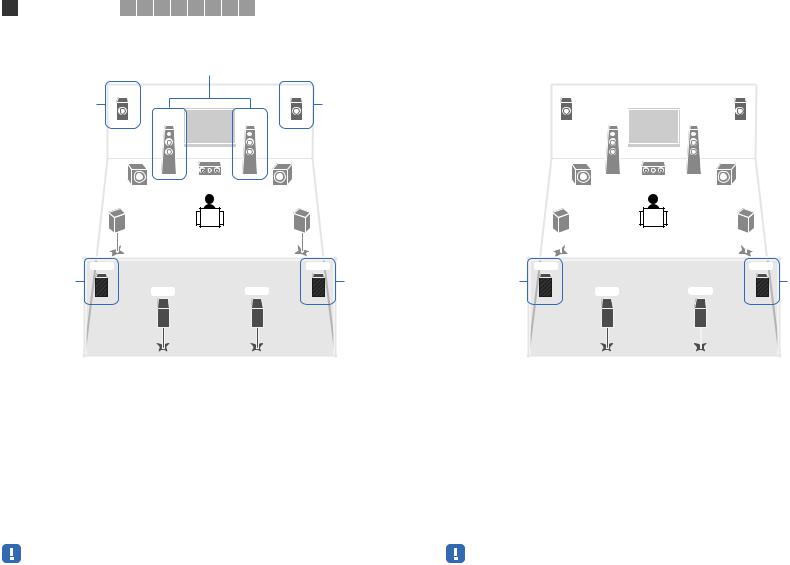
1 Speaker connections 2 3 4 5 |
6 7 8 |
9 |
|
|
|
7ch BI-AMP +FP+RP (RX-A3020 only) |
|
9ch +RP (RX-A3020 only) |
|
|
|
|
Bi-amp |
|
|
|
|
E |
|
R |
E |
|
R |
via external amp |
|
|
via external amp |
|
|
1 |
|
2 |
1 |
|
2 |
9 |
3 |
9 |
9 |
3 |
9 |
4 |
|
5 |
4 |
|
5 |
T |
Y |
|
T |
Y |
via |
via |
via |
|
via |
external amp |
6 7 external amp |
external amp |
6 |
7 external amp |
Speaker |
Connect to |
|
|
12 |
FRONT and EXTRA SP 1 (bi-amp connection) |
|
|
3 |
CENTER |
|
|
45 |
SURROUND |
|
|
67 |
SURROUND BACK |
|
|
ER |
F.PRESENCE (PRE OUT) via external power amplifier |
|
|
TY |
R.PRESENCE (PRE OUT) via external power amplifier |
|
|
9 |
SUBWOOFER 1–2 |
|
|
•When this configuration is applied, you cannot utilize the ZONE OUT/PRE OUT jacks for connecting external amplifiers for Zone2 and Zone3 (p.91).
Speaker |
Connect to |
|
|
12 |
FRONT |
|
|
3 |
CENTER |
|
|
45 |
SURROUND |
|
|
67 |
SURROUND BACK |
|
|
ER |
EXTRA SP 1 |
|
|
TY |
R.PRESENCE (PRE OUT) via external power amplifier |
|
|
9 |
SUBWOOFER 1–2 |
|
|
•When this configuration is applied, you cannot utilize the ZONE OUT/PRE OUT jacks for connecting an external amplifier for Zone3 (p.91).
PREPARATIONS Connecting speakers |
En 27 |
|
|
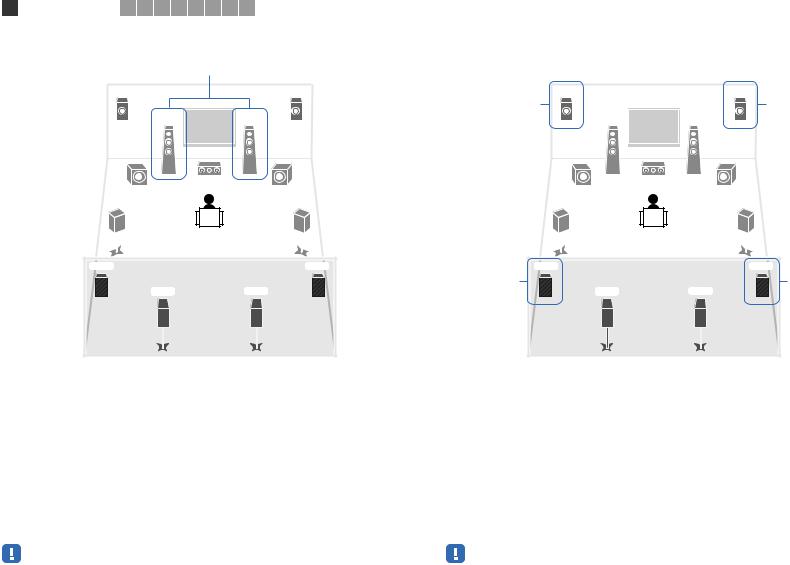
1 Speaker connections 2 3 4 5 |
6 7 8 |
9 |
|
|
|
9ch +FRONT (RX-A3020 only) |
|
|
7ch +FP+RP (RX-A3020 only) |
|
|
via external amp |
|
|
|
||
E |
|
R |
E |
|
R |
|
|
|
via external amp |
|
via external amp |
1 |
|
2 |
1 |
|
2 |
9 |
3 |
9 |
9 |
3 |
9 |
4 |
|
5 |
4 |
|
5 |
T |
Y |
T |
Y |
|
via |
|
via |
6 7 |
external amp |
6 |
7 external amp |
Speaker |
Connect to |
|
|
12 |
FRONT (PRE OUT) via external power amplifier |
|
|
3 |
CENTER |
|
|
45 |
SURROUND |
|
|
67 |
SURROUND BACK |
|
|
ER |
EXTRA SP 1 |
|
|
TY |
EXTRA SP 2 |
|
|
9 |
SUBWOOFER 1–2 |
|
|
•When this configuration is applied, you cannot utilize the ZONE OUT/PRE OUT jacks for connecting an external amplifier for Zone3 (p.91).
Speaker |
Connect to |
|
|
12 |
FRONT |
|
|
3 |
CENTER |
|
|
45 |
SURROUND |
|
|
67 |
SURROUND BACK |
|
|
ER |
F.PRESENCE (PRE OUT) via external power amplifier |
|
|
TY |
R.PRESENCE (PRE OUT) via external power amplifier |
|
|
9 |
SUBWOOFER 1–2 |
|
|
•When this configuration is applied, you cannot utilize the ZONE OUT/PRE OUT jacks for connecting external amplifiers for Zone2 and Zone3 (p.91).
PREPARATIONS Connecting speakers |
En 28 |
|
|
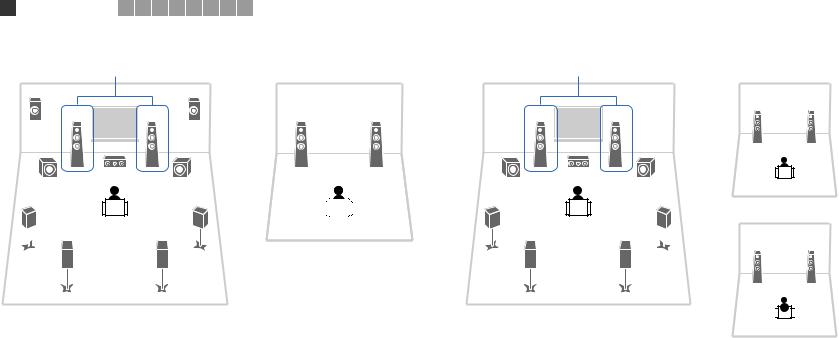
1 Speaker connections 2 |
3 4 |
5 6 7 8 9 |
|
|
|
|
|
|
7ch +FRONT+1ZONE |
|
|
|
5ch +FRONT+2ZONE |
|
|
||
|
via external amp |
|
|
|
via external amp |
|
||
E |
|
|
R |
|
|
|
|
|
|
|
|
|
|
|
|
1 |
2 |
|
1 |
2 |
1 |
2 |
|
1 |
2 |
|
9 |
3 |
|
9 |
|
9 |
3 |
9 |
|
4 |
5 |
4 |
5 |
Zone2 |
|
|
|
|
|
6 |
7 |
6 |
7 |
|
|
|
Zone3 |
1 |
2 |
|
|
|
|
Main zone
Speaker |
Connect to |
|
|
12 |
FRONT (PRE OUT) via external power amplifier |
|
|
3 |
CENTER |
|
|
45 |
SURROUND |
|
|
67 |
SURROUND BACK |
|
|
ER |
EXTRA SP 1 |
|
|
TY |
(not used) |
|
|
9 |
SUBWOOFER 1–2 |
|
|
Zone3 speakers |
EXTRA SP 2 |
|
|
|
Main zone |
|
|
|
Zone3 |
||
|
|
||
Speaker |
Connect to |
||
|
|
||
12 |
FRONT (PRE OUT) via external power amplifier |
||
|
|
||
3 |
CENTER |
||
|
|
||
45 |
SURROUND |
||
|
|
||
67 |
SURROUND BACK |
||
|
|
||
ER |
(not used) |
||
|
|
||
TY |
(not used) |
||
|
|
||
9 |
SUBWOOFER 1–2 |
||
|
|
||
Zone2 speakers |
EXTRA SP 1 |
||
|
|
||
Zone3 speakers |
EXTRA SP 2 |
||
|
|
|
|
PREPARATIONS Connecting speakers |
En 29 |
|
|
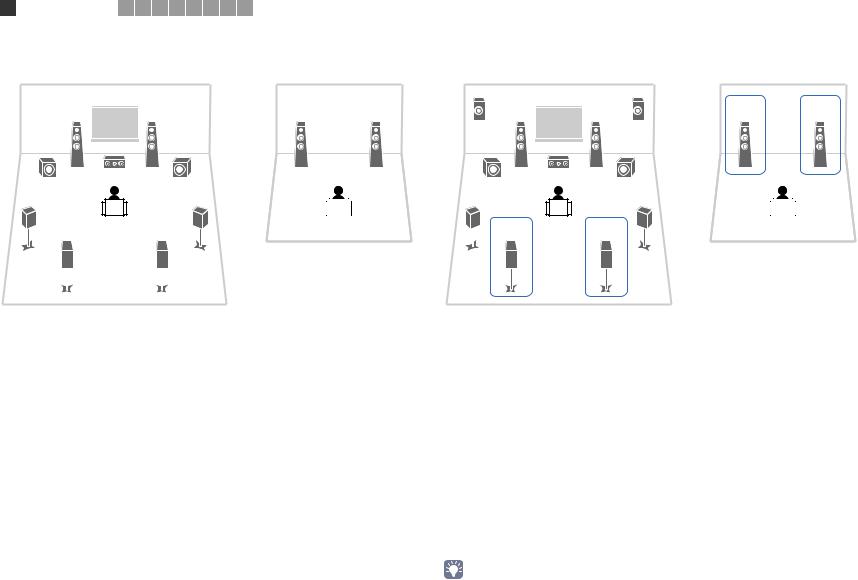
1 Speaker connections 2 |
3 4 5 6 7 |
8 9 |
|
|
|
|
|
|
7ch +1ZONE |
|
|
|
|
9ch +1ZONE |
|
|
|
|
|
|
|
|
E |
|
R |
|
1 |
|
2 |
1 |
2 |
1 |
2 |
1 |
2 |
9 |
3 |
9 |
|
|
9 |
3 |
9 |
|
4 |
5 |
4 |
5 |
6 |
7 |
6 |
7 |
|
Zone2 |
|
Zone3 |
Main zone
Speaker |
Connect to |
|
|
12 |
FRONT |
|
|
3 |
CENTER |
|
|
45 |
SURROUND |
|
|
67 |
SURROUND BACK |
|
|
ER |
(not used) |
|
|
TY |
(not used) |
|
|
9 |
SUBWOOFER 1–2 |
|
|
Zone2 speakers |
EXTRA SP 1 |
|
|
Main zone
Speaker |
Connect to |
|
|
12 |
FRONT |
|
|
3 |
CENTER |
|
|
45 |
SURROUND |
|
|
67 |
SURROUND BACK |
|
|
ER |
EXTRA SP 1 |
|
|
TY |
(not used) |
|
|
9 |
SUBWOOFER 1–2 |
|
|
Zone3 speakers |
EXTRA SP 2 |
|
|
• When Zone3 output is enabled (p.95), the surround back speakers in the main zone do not output sound.
PREPARATIONS Connecting speakers |
En 30 |
|
|
